Hmmm… Paris. What to say??

We just had a wonderful time in Paris, again. It’s still my favorite city to visit in the world.
We chose to focus on museums this visit. We even hit a few for a second time. As you can tell, these images come from the Rodin Museum. We loved his bronze work. It’s so easy to feel the emotion and understand why he’s the most acclaimed artist since Michelangelo.
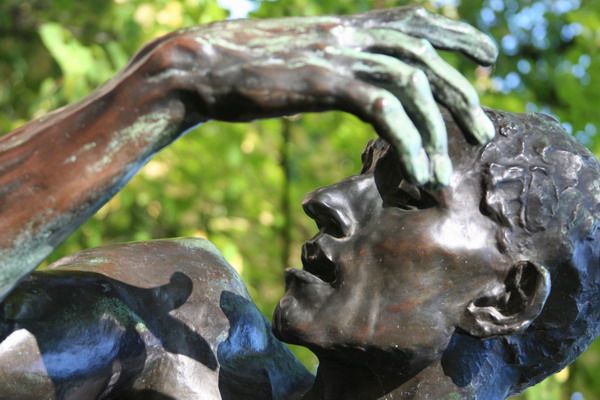
We also visited the Musee d’Orsay. If you’re not familiar with this
spectacular gallery, it’s a train station built at the turn of the 20th century that was turned into a museum to pick up in art history where the Louvre left off, Impressionism. It’s a great venue and a work of art in itself.
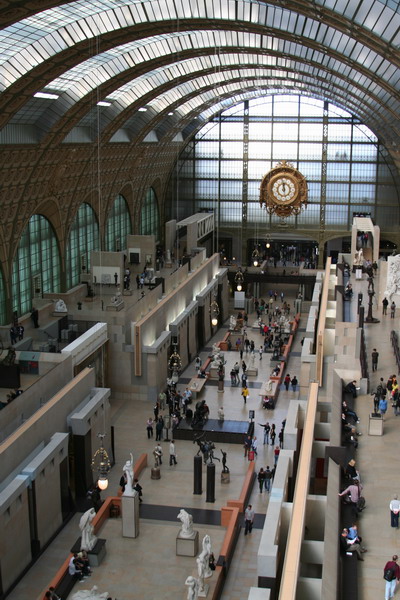
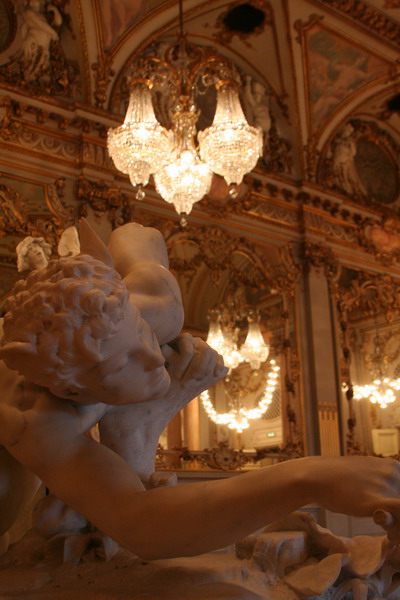
Through the clock is Sacre Coeur.
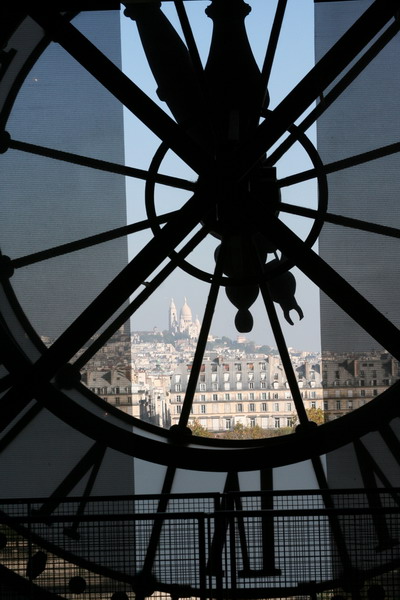
We also visited the magnificent Chateau de Versailles. What began as a hunting lodge in 1624, became the full time home of the French Sun King, Louis XIV in 1682. His heirs, Louis XV and the infamous Louis XVI and wife, Marie-Antoinette also ruled from this palace.
This is the Chapel, where the King had daily mass.
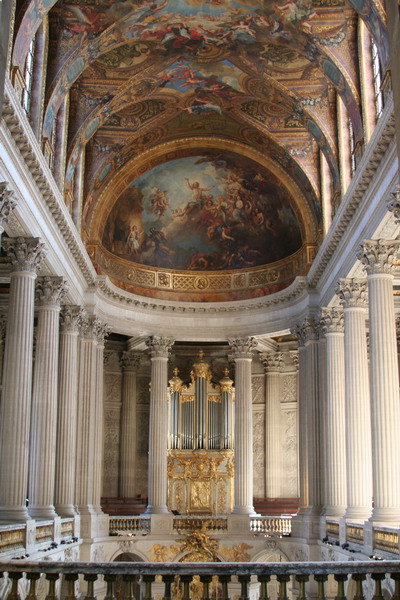
Here is the bust of the Sun King himself. He was revealed in this piece of marble by the great Bernini.
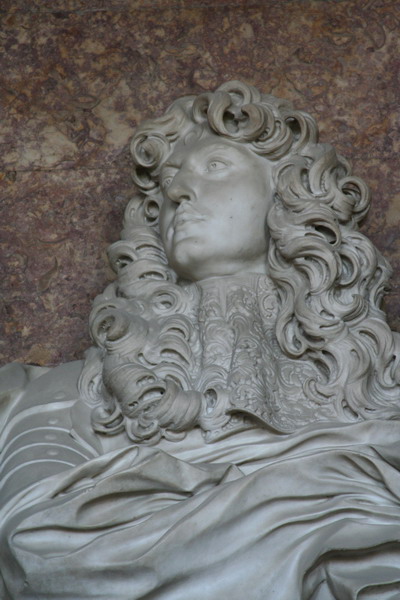
The rooms of the chateau were stunning.
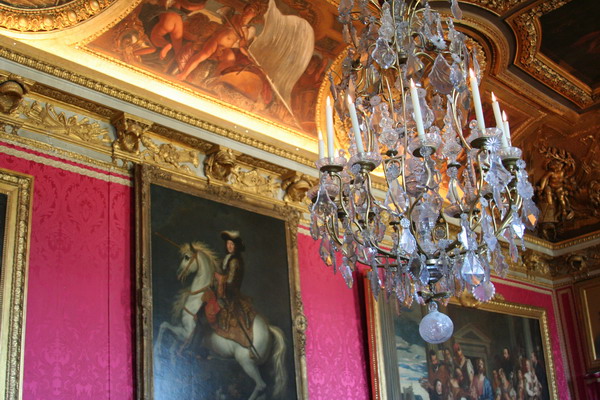
In 1678 the back terrace was turned into the most famous (and grand) room, the Hall of Mirrors. To give you an idea of the scale, it measures 250 feet long by 35 feet wide and 40 feet high. Its massive proportions are added to by it’s historic significance. In 1919, Germany signed the Treaty of Versailles which ended World War I.
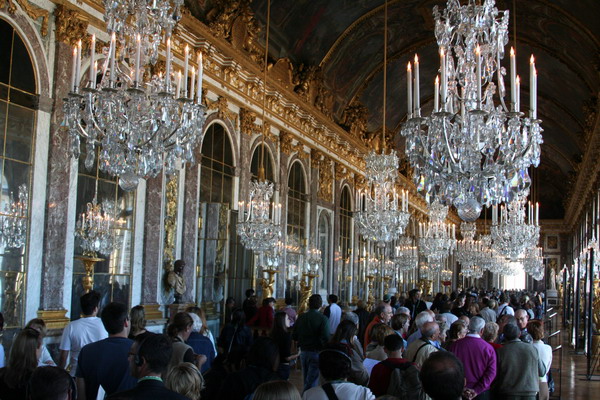
The artwork adorning the walls is often of the royal family. In this case, it’s the infamous Marie-Antionette and her children. Pictured are her eldest daughter, Madame Royale, the Dauphin (AKA heir apparent), Louis-Joseph (born in 1781), stands next to her while the third child (the future Louis XVII, born in 1785) is on her knees. This was painted a mere 6 years before the start of the French revolution. In some ways, the queen began the bloody revolution. However, the much-attributed phrase, “Let them eat cake” was probably not even uttered by Queen Marie-Antoinette (although it may have been). Similar to the way the Boston tea Party united the American colonies against the British, a certain diamond necklace united the French proletariat against the aristocrats and monarchy.
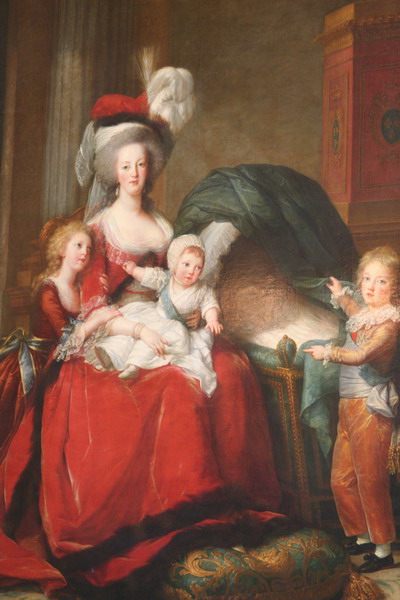
Here’s the story of the necklace and the queen: there is a young noble woman (on the verge of bankruptcy) who plays two men’s belief (the Cardinal of France and a jeweler) that she has the favor of the queen (Marie-Antoinette). So, she convinces the Cardinal to buy a 2,800 carat diamond necklace from the jeweler, give it to the noble woman, who would then (supposedly) give it to the queen. The idea was that the cardinal would then be able to gain the queens favor with this gift. Unfortunately, the necklace never made it to the queen and when she got the bill, the pieces fell into place. She and her husband Louis XVI, were furious with the cardinal and his disrespect. So, they demanded a public trial. Unfortunately, the cardinal was acquitted, but the noble woman was found guilty, flogged and imprisoned. However, since the jury had rebuked the French sovereign (a new precedent), it in fact marked a turning point and signaled the impending revolution.
Now, here is the view from the back of the chateau, overlooking the immense gardens.
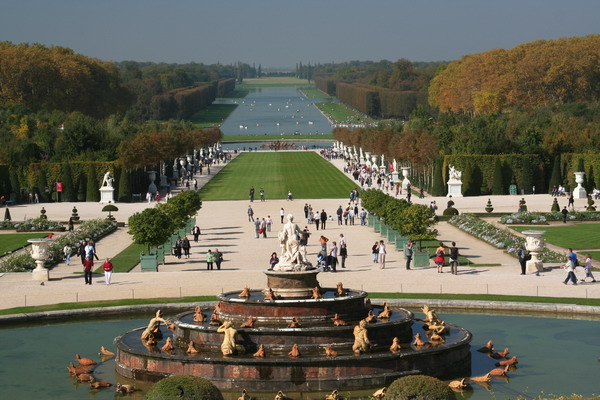
Here is the view back to the chateau.
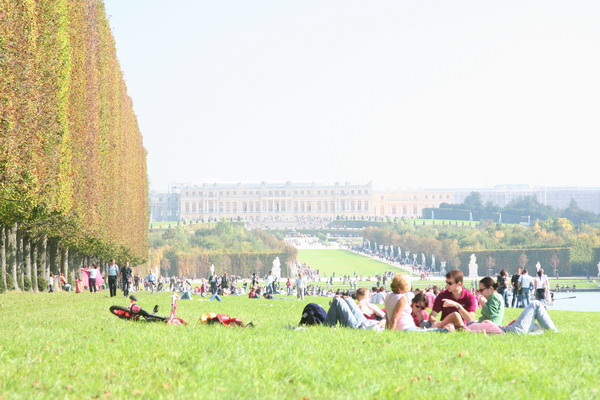
Next stop was the Panthéon in the Latin Quarter (just up the street from our hotel). It began as a church to St Genevieve, but has become a burial place for famous/influential French. One of the more interesting residents is Voltaire. Here is his crypt.
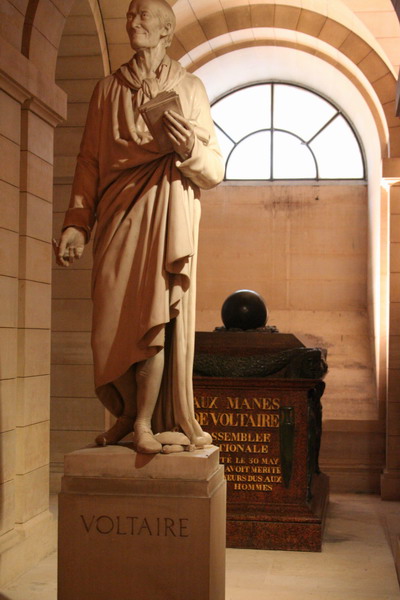
Here is the inside of the Panthéon, with my favorite touring partner.
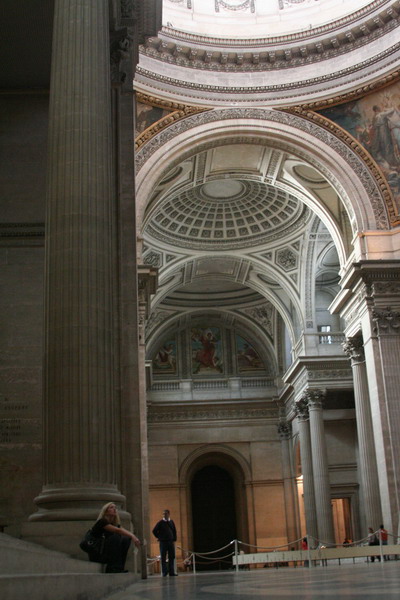
Also housed inside is something called a Foucault Pendulum. This was a device conceived by the French scientist of the same name in 1851 who wanted to physically prove the rotation of the earth (although that was already commonly accepted knowledge). His experiment was to mount a weight at the end of a long wire, release it and watch as the weighted bob moved a known amount with each passing arc, proving the Earth rotated underneath the swinging weight. This created quite a fervor in both the academic and and layman worlds. It was tangible proof that the Earth rotates in an easy to set up experiment.
As a side note, if you perform this experiment at the poles, the bob will trace a complete circle in the 24 hours the Earth make one complete revolution. Here, it went just over 270 degrees each day. You can see, it’s just about 5 PM in this picture.
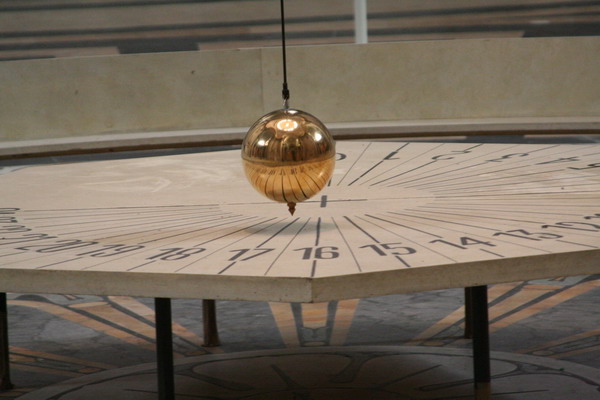
As night falls in the city of romance, the lights come on to illuminate sight like the stunning Notre Dame. Construction took about 200 years, but was finally completed around 1250.
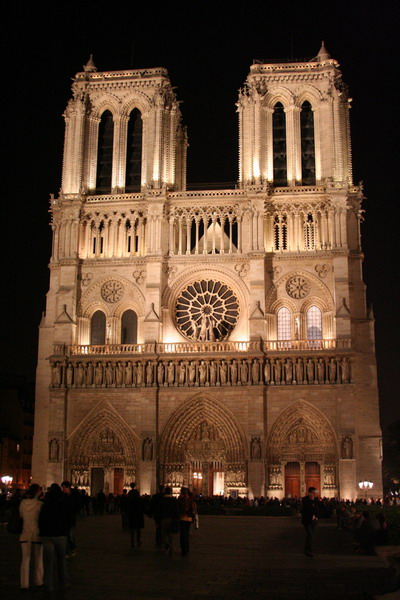
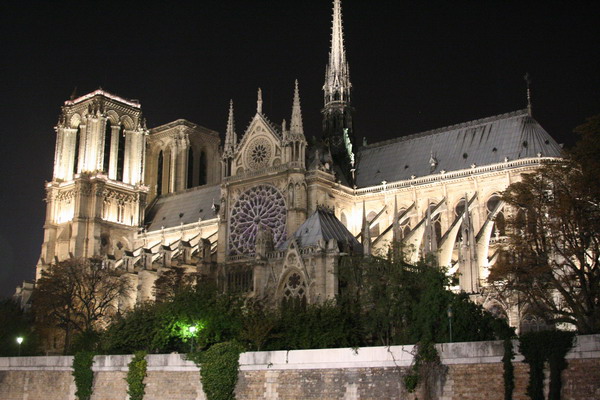
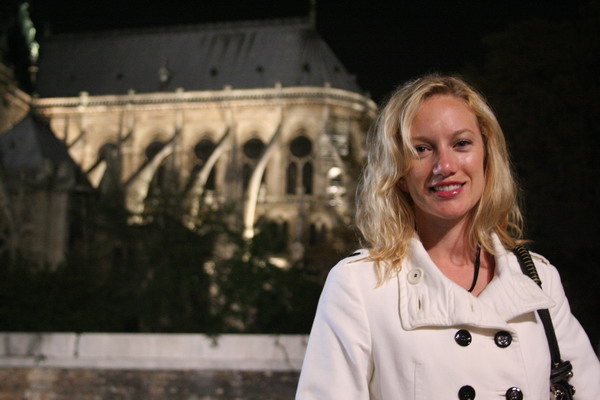
The metro is a great way to get from site to site in the city.
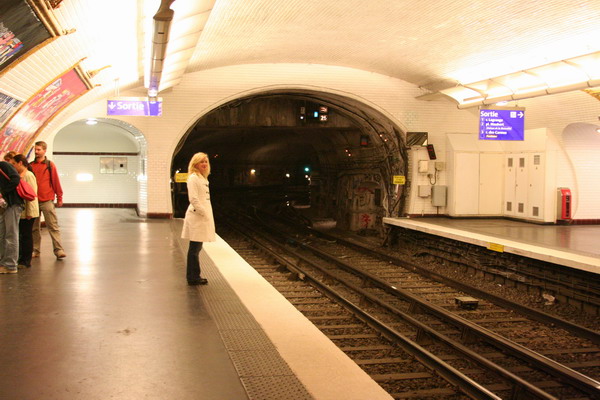
We also decided to go back to a couple familiar, but never common sites that are great after dark. The first is of course, the Arc de Triomphe.
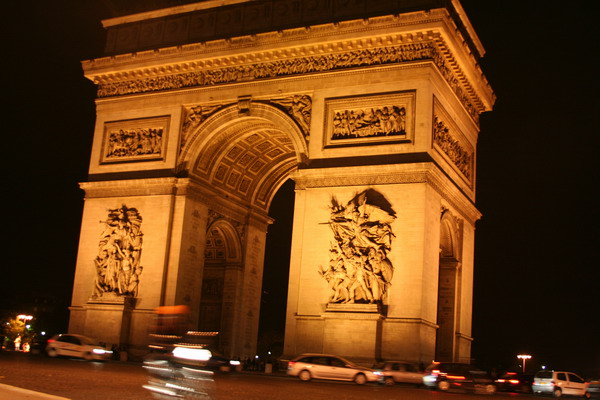
This relief is called the Departure of the Volunteers of 1792, or commonly La Marseillaise. This is interesting because it’s a unique sculpture where Liberty is cheering on the French people to rid themselves of tyranny. Also, the French national anthem is La Marseillaise and its lyrics are very similar to the emotion seen in this sculpture.
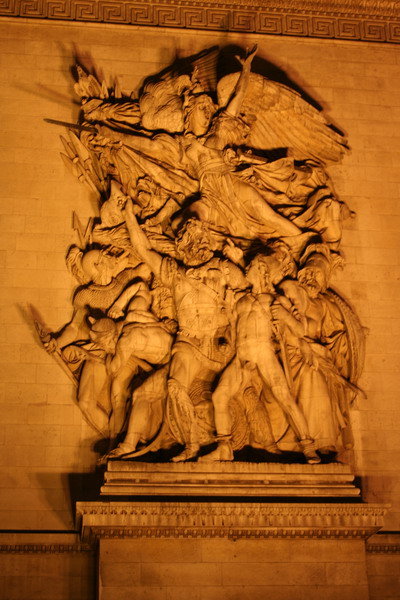
This time, we decided to visit the small museum in the top and go out to view the city from the top of the landmark where all roads converge.
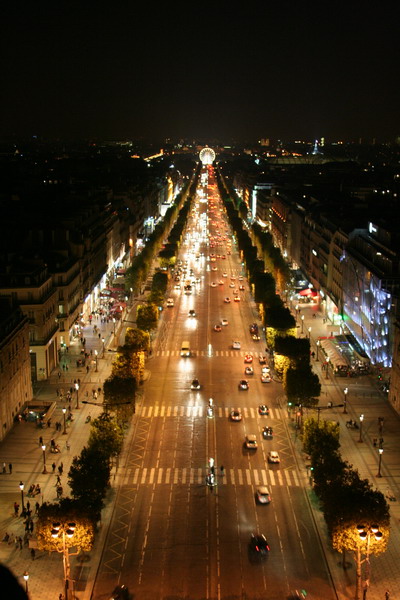
Then, over to the quintessential monument to late 19th century French engineering.
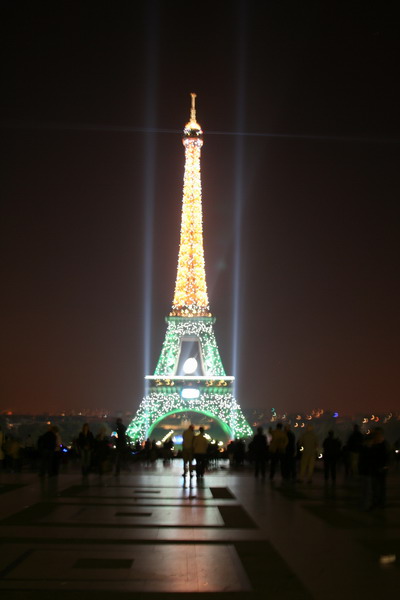
A view from the second floor of the tower.
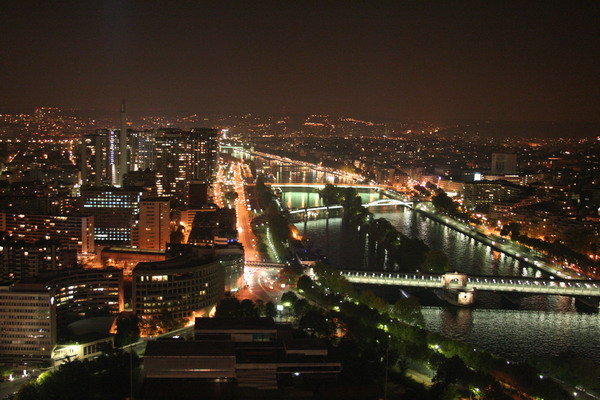
This is from 400′, looking up to the 1,000′ peak of the tower.
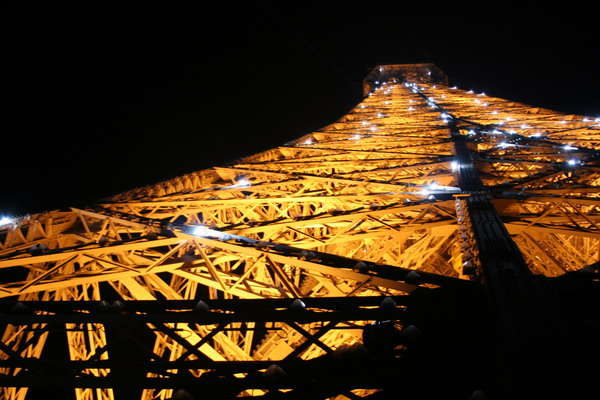
Reflecting back on the beauty of this landmark.
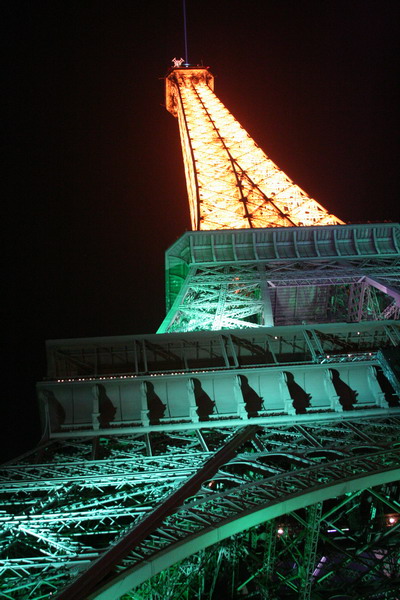
Yet again, we fell in love with the city. It was a great way to complete our re-connection time together, in the city of romance, love and science.
But, now we must wait a little while before traveling again.
So, until then.
–Jim
Author: jim
Venice, Italy
For our first “real” trip together again, we chose to visit the ultra-romantic city of Venice to get re-acquainted.
Although much acclaimed in history and pop culture, Venice is a relatively small town with only 65,000 people living in the city that is shaped like a fish. Our hotel was conveniently located near where the dorsal fin would be. However, since Venice is more like a town than city, everything is close.
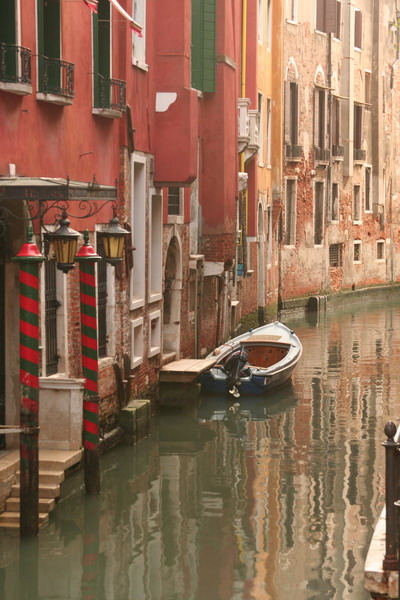
We spent a lot of time cruising on the vaprettos (like a water borne bus), or just wandering around. We thought the best part of Venice was simply taking it in as we passed from canal to canal surrounded by beautiful architecture.
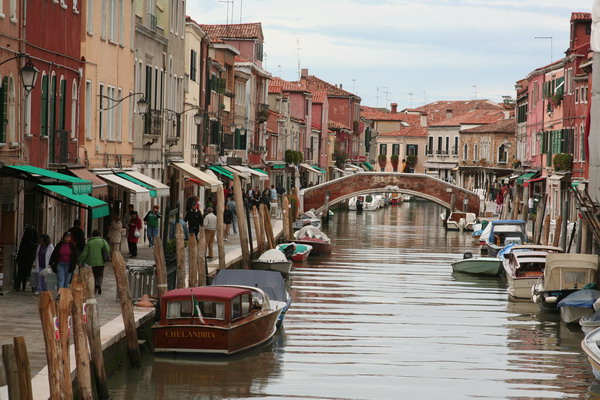
Of course, the gondolas were everywhere.
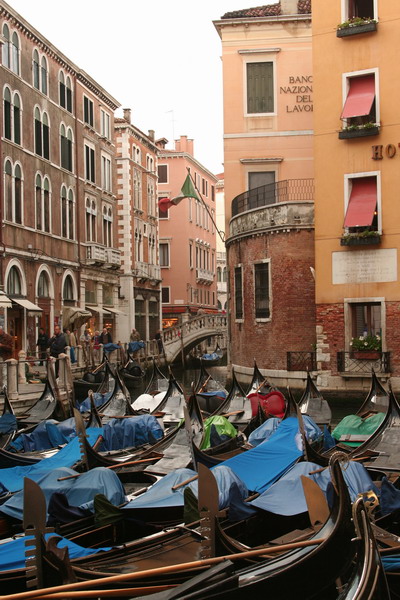
There is no real significance to these buildings. I just liked the way they look.
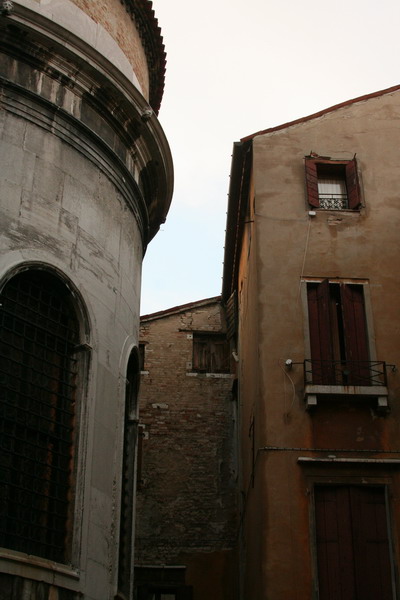
Saint Mark’s Square is probably the most famous landmark in Venice. There are a number of interesting museums in addition to the large church and bell tower you see in this picture. The building on the far right is the Doge’s Palace. Venice was an autonomous city-state for over 1,000 years, and this is where the elected leader lived and conducted business. Venetian government uses an interesting method. There is a grand council of noble or aristocratic families that elect 120 senators. Those 120 elect 1 man to be the Doge (or Duke) for life. He is the nominal leader of the city. However, his power was checked by a number of bodies, like the Council of Ten. This group decided pretty much on everything from foreign relations to financial matters. They were important all the way until 1797 when Napoleon conquered the city and dissolved the council.
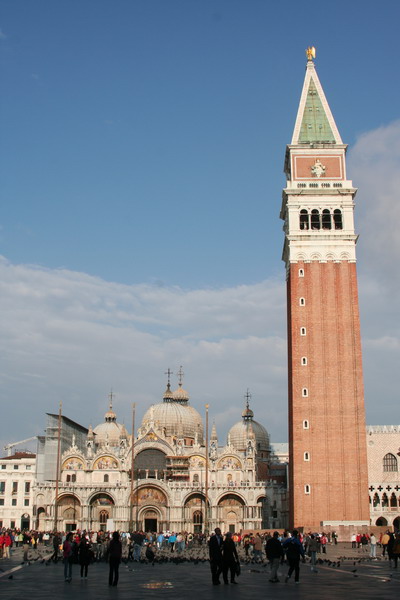
The pigeons of St Mark’s square are almost as famous as the buildings. They have gotten VERY used to being fed by the tourists.
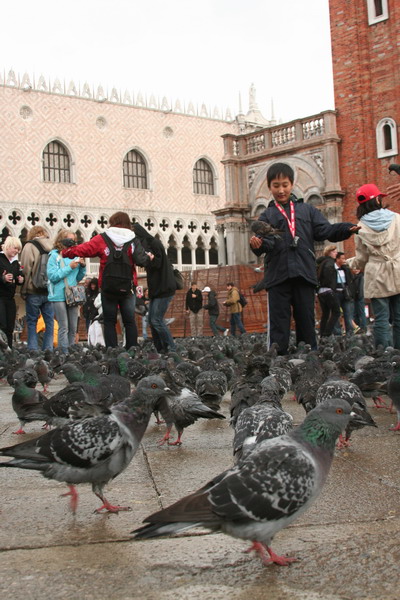
A bag of bird food provides much entertainment (not to mention amusement for those nearby).
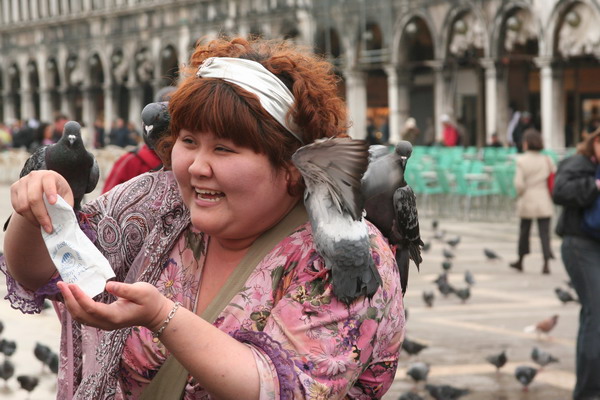

They have gotten so used to interacting with humans that even if you don’t have any food, they will land right on you.
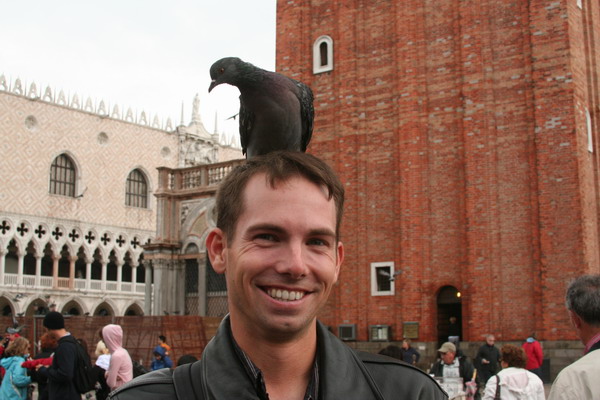
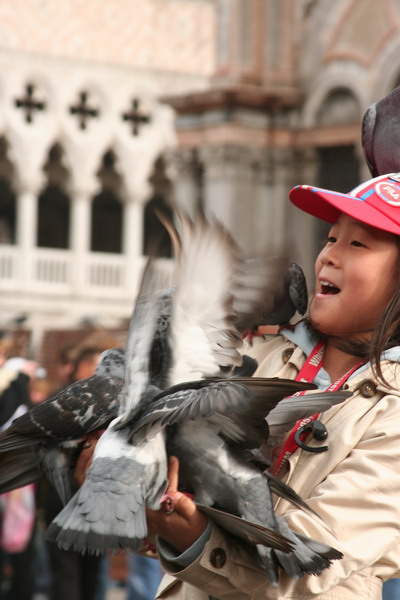
More gondolas.
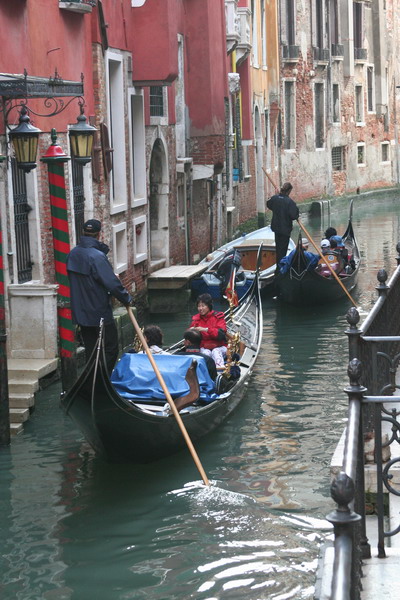
This image is the Grand Canal. It is Venice’s aqueous main street.
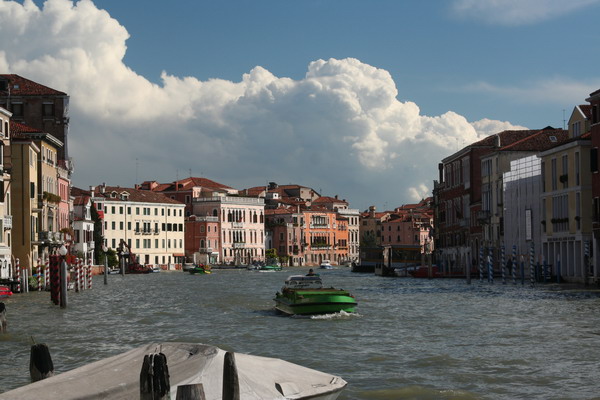
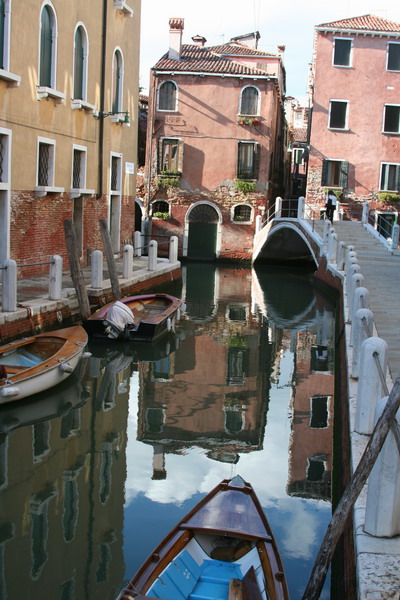
Some of the streets run right into the canals.
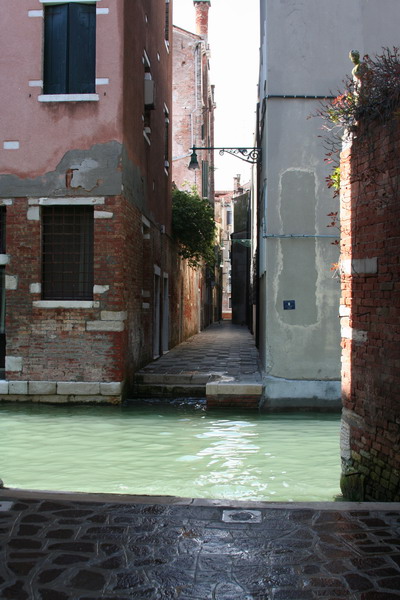
More canals and gondolas.
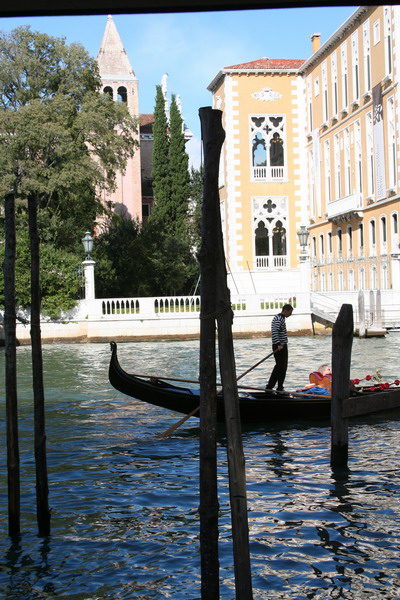
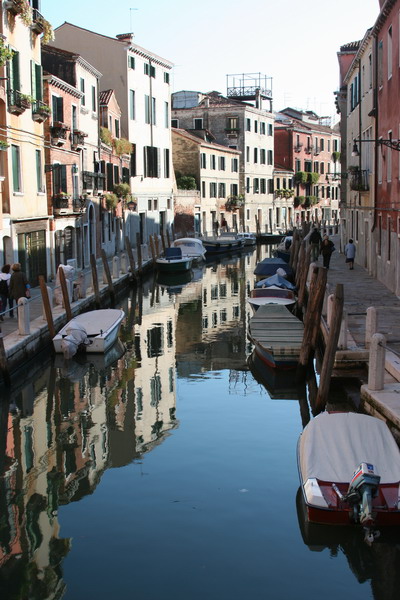
Creating glass has been a part of Venice almost since it’s inception. However at the end of the 13th century, the industry moved to the island of Murano to lessen the risk of a catastrophic fire in the city center.
We decided to hop on a ferry and check out the world-renowned Murano glass. It did not disappoint. Here are a couple images from a glass factory. The master in charge (on the right) spent 25 years learning the trade before he was even considered to be a master.
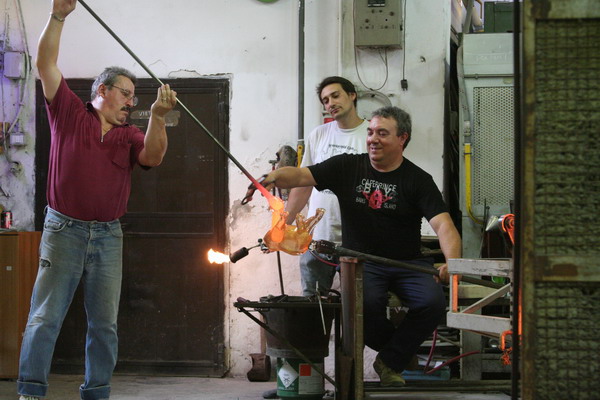
The glass objects they produce are truly works of art.
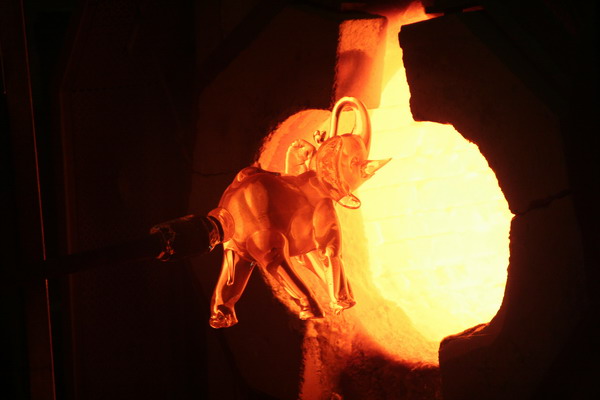
Back in the grand canal, gondoliers continue to paddle love-struck tourists around.

Some came complete with a serenade.
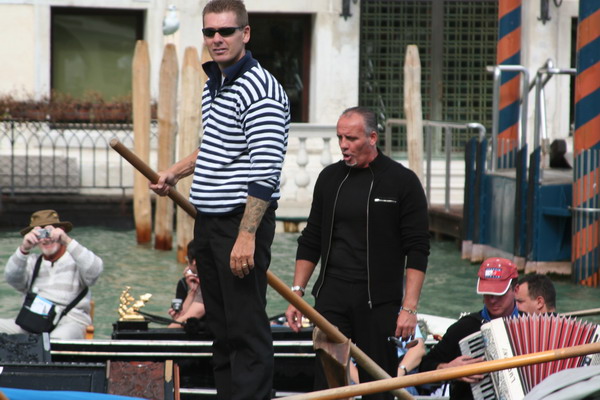
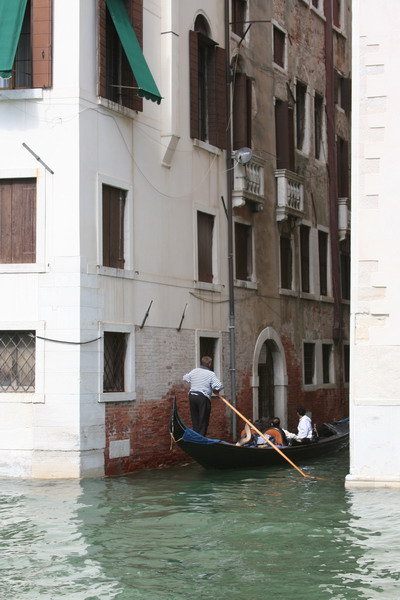
This is the Rialto Bridge. It is another architectural landmark of the city. This is the third bridge in this location, completed in 1591. The two earlier bridges were wooden and could open to permit passage of large ships. However, since this 160 foot stone span was built to last, that accommodation ended. Nevertheless, Rialto continues to be the commercial district of Venice.
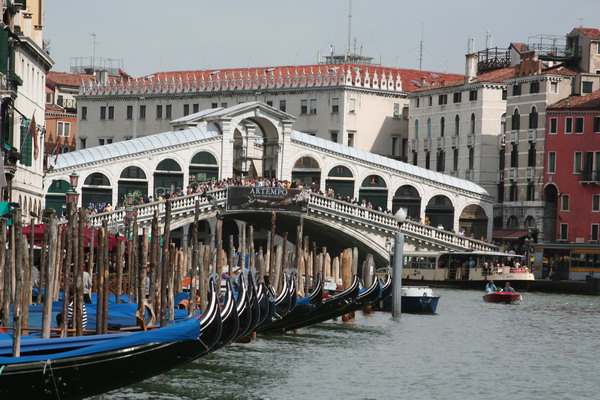
Another gondolier.

Since Venice is as close to sea level as you can get, it is very affected by tides and changing water levels. Unfortunately, in addition to the rising sea levels that are much touted in the media these days (the actual magnitude of that rise is debatable), the foundations of the city have sunk several inches AND the local tide levels have increased several inches. So, the combination of all three of those factors means that the city of canals deals with flooding on a regular basis. This is just a small example of what is happening.
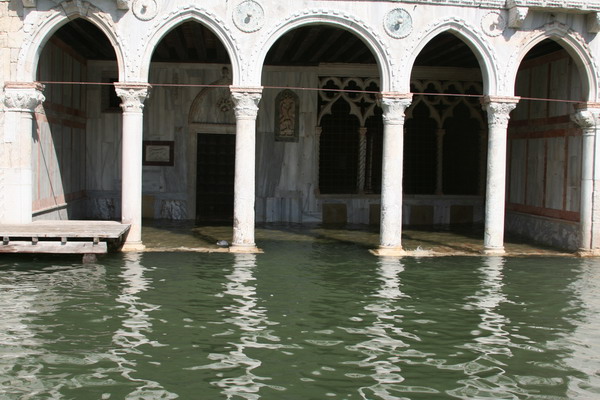
Venice by night is an experience all romantics need to have. It is simply amazing.
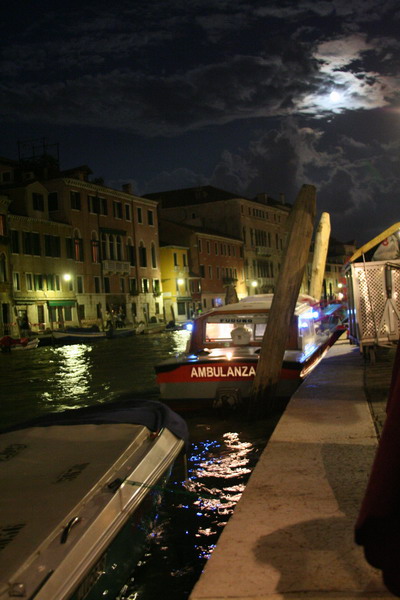
The great violin virtuoso and composer, Antonio Vivaldi called Venice home. Now, musicians pay homage daily and his familiar tunes can be heard in a number of concert halls every night. We chose to hear a well played rendition of his “Four Seasons.” Anna and I decided that Fall was our favorite season.
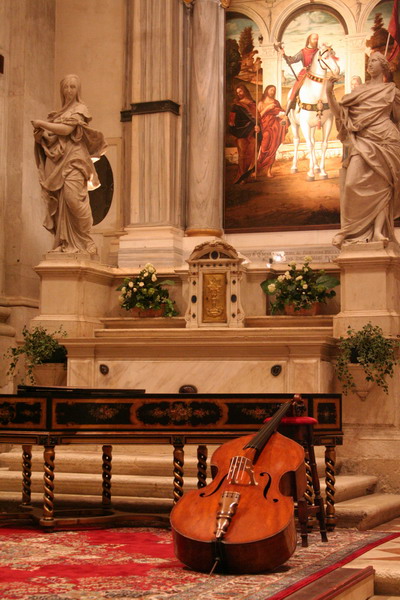
Images from a couple of nearby restaurants.
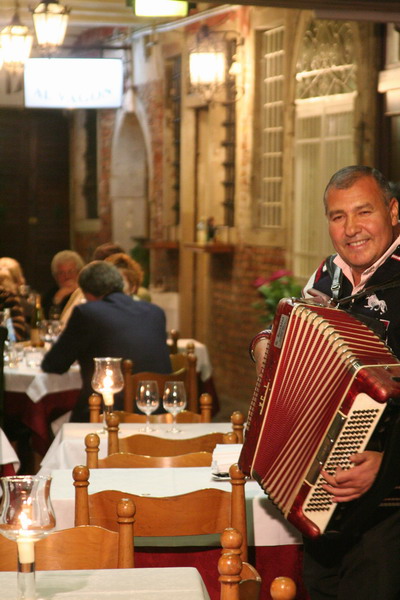
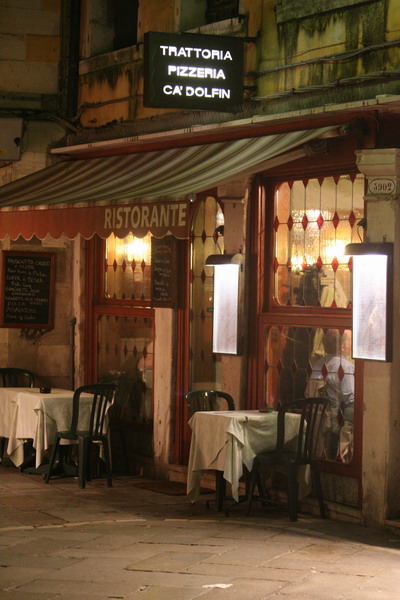
This is the view at night from the Rialto bridge. Everything becomes triply romantic in the city after dark.
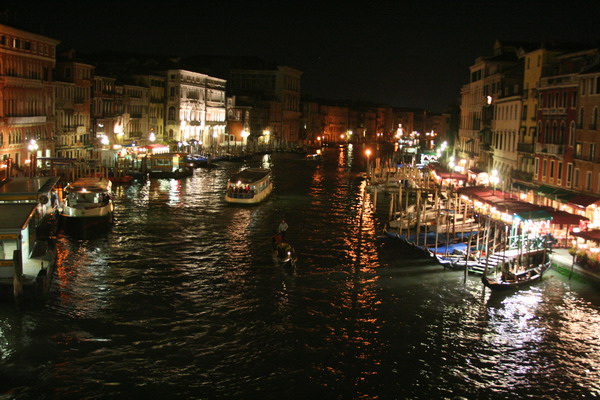
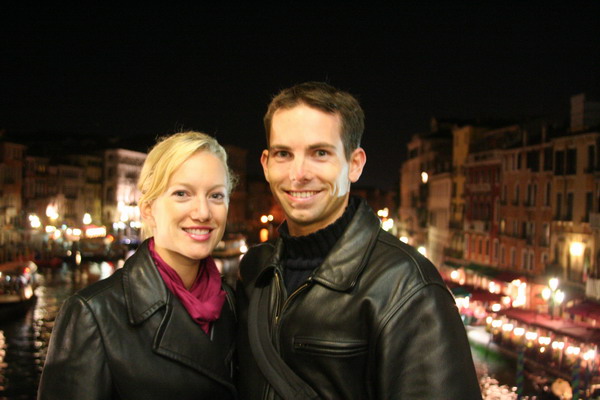
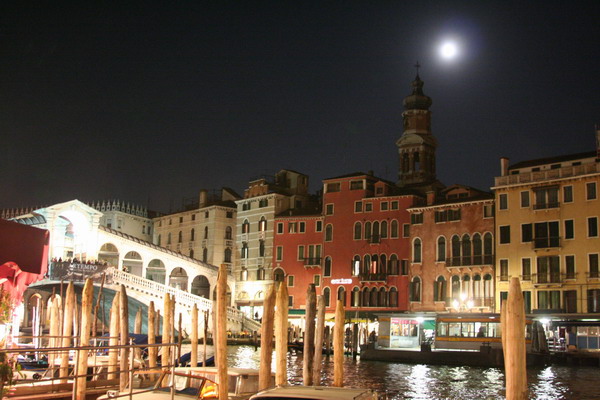
Anna didn’t have a hard time finding gelato she liked.
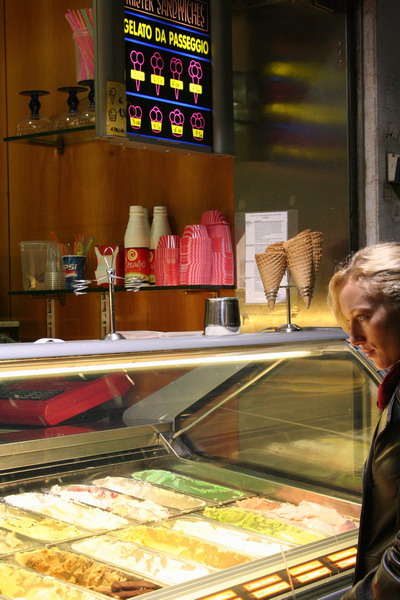
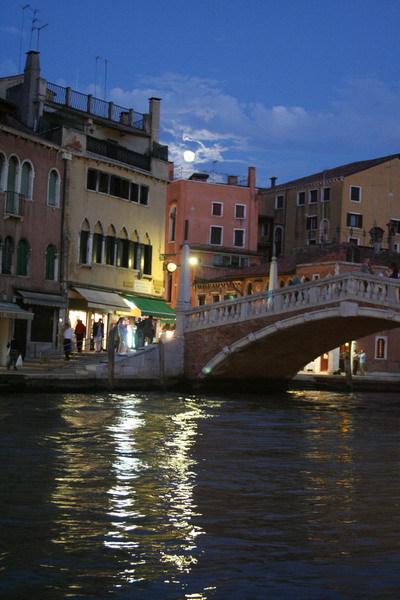
That concludes our visit to the romantic city of Venice. It was a great place to get close again.
I am finishing this post from our hotel in Paris. So, soon I will have the next installment of our romantic adventures in Europe.
Until then…
–Jim
International Hike
As you can tell from this post, I have come home from Iraq. It was a great (albeit challenging) experience. If you’re interested, the previous three posts have a few details.
However, one of the first orders of business was to go out into the incredibly green forest (especially to color deprived eyes). The first day was on this hike from Trier across the border into Luxembourg, and the second was an almost 60 mile (100km) bike ride. But, since I only have a few pictures of the hike, this will be a short one. We ventured out into the wilds of Germany with our good friend Ken (who you may recall from our Budapest trip earlier this year).
Now on to the hike: since we hiked along side of (or at least in sight of) the Mosel River for a long way, there were plenty of late season grapes (very sweet).

We also happened across this interesting fellow (I mean the slug, not Ken…).
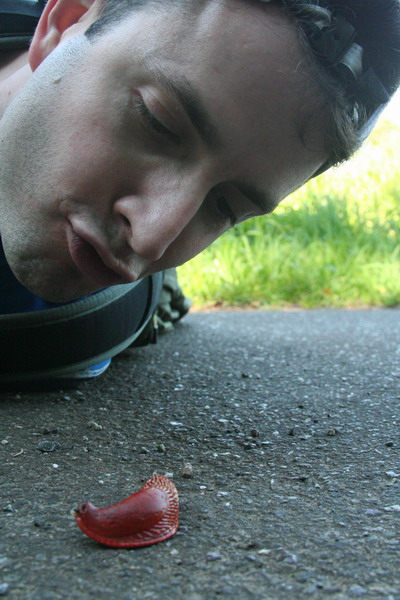
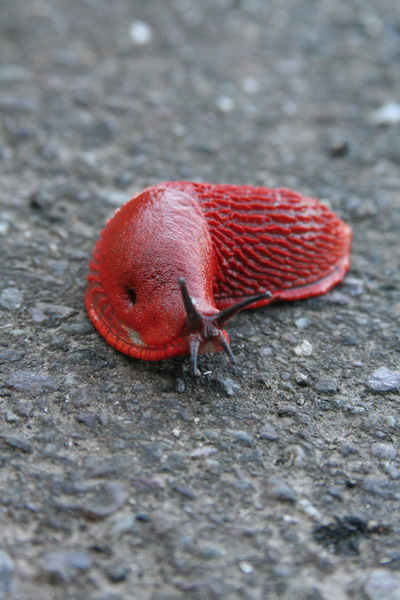
Conveniently, Ken had brought some carrots which made a perfect snack for our new friends.
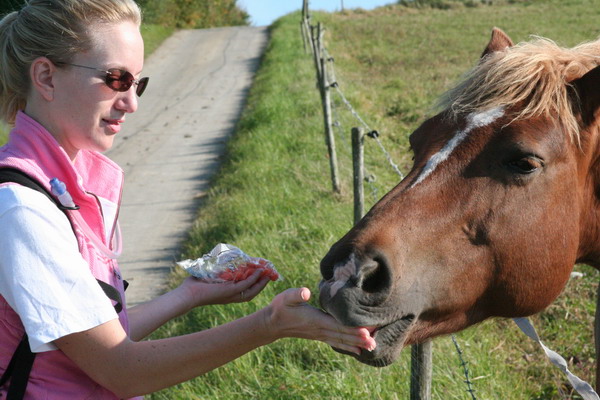
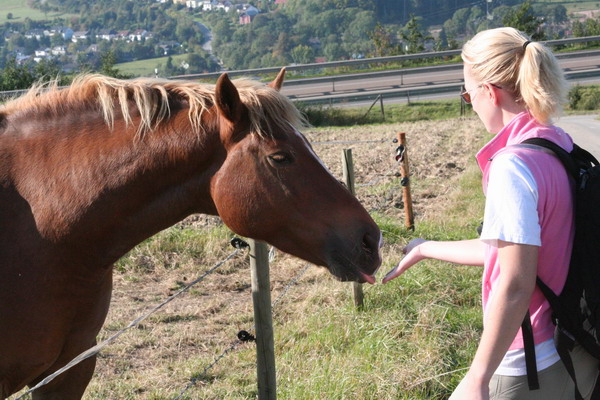
In fact, they were even posing for Ken’s pictures. She really liked the wind.
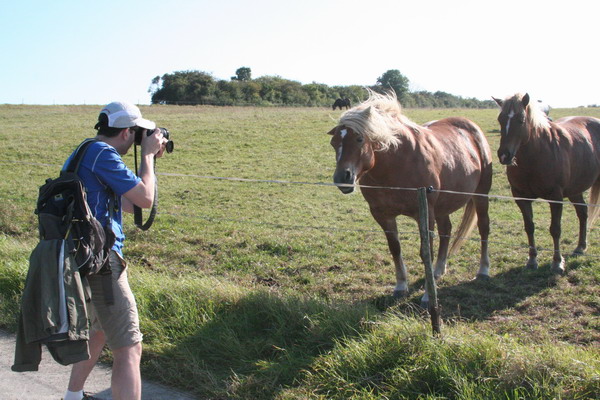
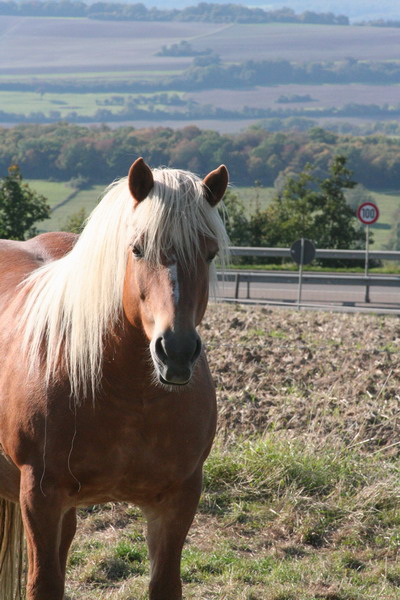
Ken got very creative with his images and posted a montage on One True Media. If you’d like to see the slideshow, make sure your speakers are turned on and follow this link:
international hike
So, that concludes our hike across the border. The next post will detail our first “real” trip together again. We just visited the stunningly romantic city of Venice. So, until then.
–Jim
Iraq — day to day, part 2
While the US has been on this base for a relatively short period of time, the base has been around since the 1930’s.
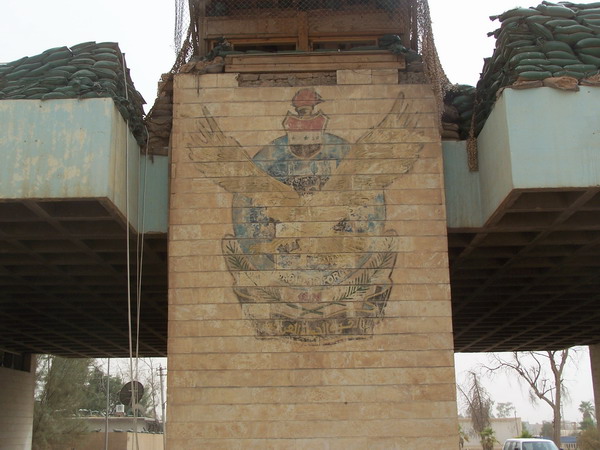
One of the areas we are responsible for is minor construction. So, we’ve been busy building things all over the base. This is one of our larger projects. We built several offices and a conference room for the Army. Nail guns are very handy for framing walls.
Although Clay (holding the nail gun) is an entomologist, he helped out with a lot of the construction. It just shows how multi-skilled the guys are.
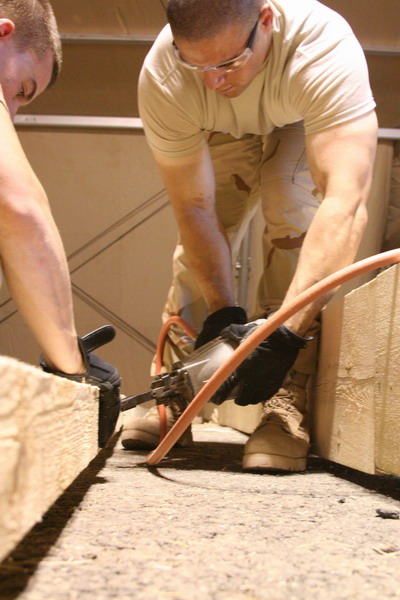
Chris was my project lead for a couple large projects (including this one). He did a great job. Actually, all my Airmen have been an outstanding team. Any success we’ve had is directly because of their skills and hard work.
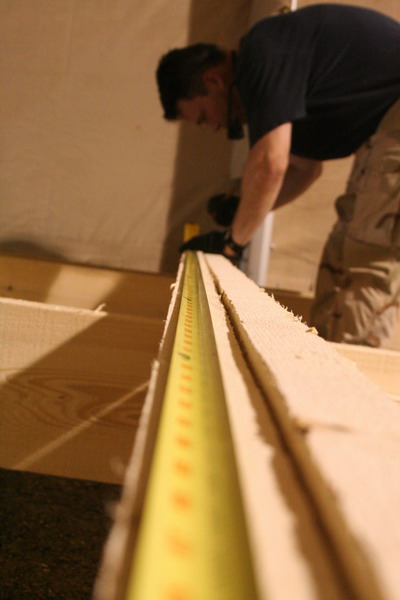
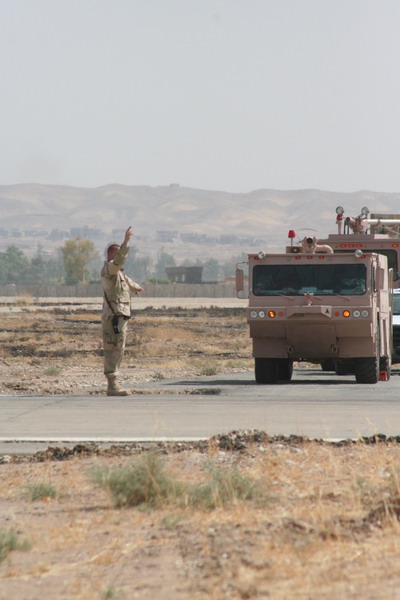
Although Rob is our first sergeant and responsible for the morale, welfare, and conduct of all enlisted members of the squadron, he is also a power pro expert and helped out the guys in the shop quite a bit.
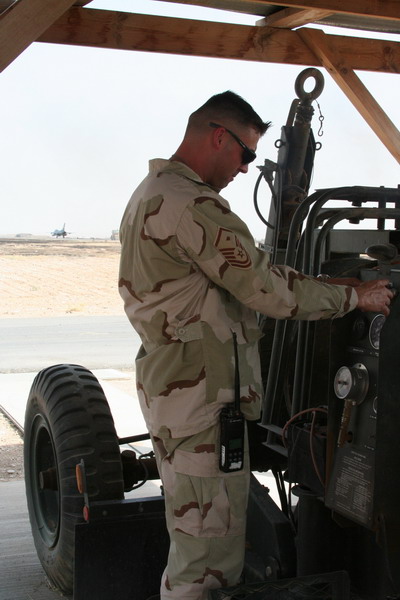
He even taught a medic, Yvonne, how to run some of the equipment.
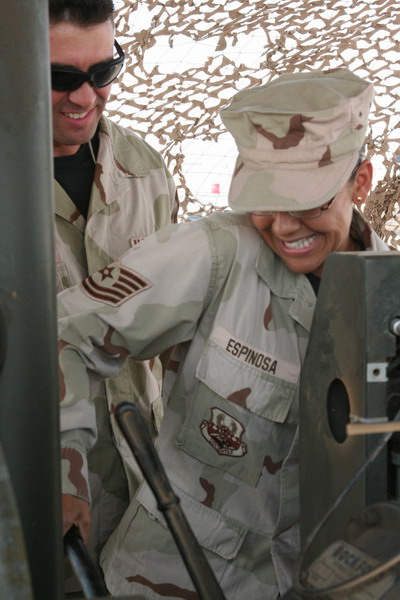
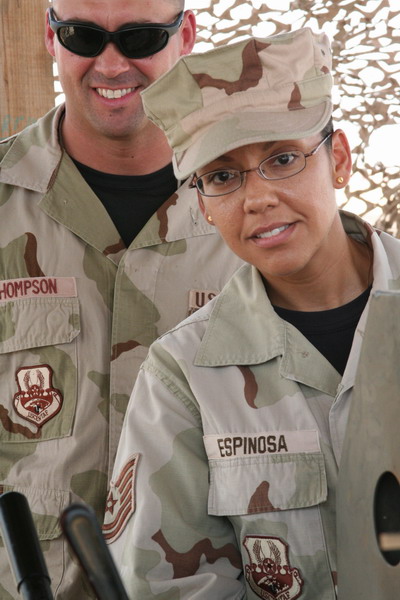
You can see the sort of dust storm the helicopters kick up.
My Structures Airmen are not only skilled with wood, they can also create metal works of art.
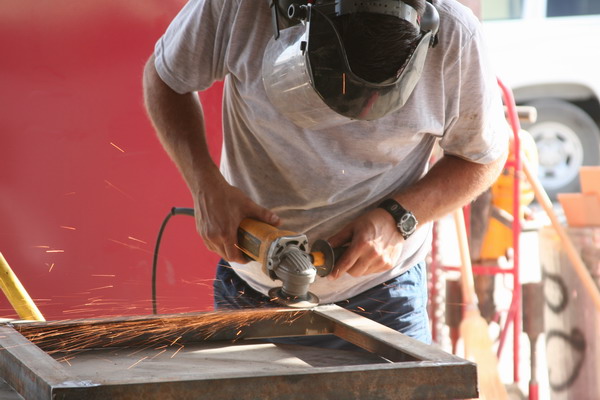
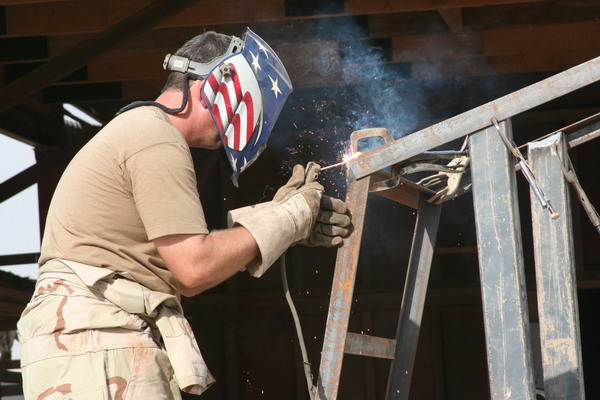
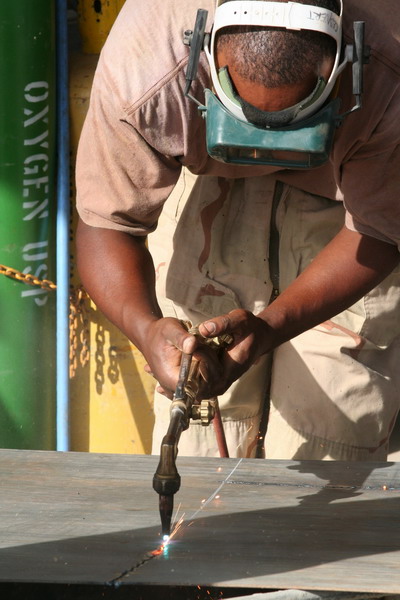
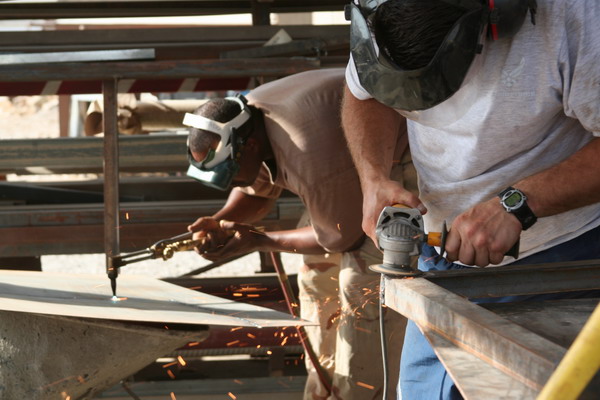
Plumbers have, without question, one of the dirtiest, under-appreciated, but most important jobs. The picture below is of a pump that failed on the sewage line. They worked through the night to fix it and ensured that sewage kept flowing where it was supposed to. People flush the craziest things down the toilet… I’ll just leave it at that.
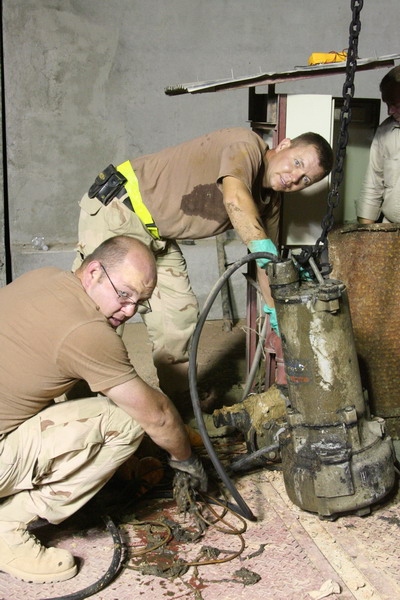
The utilities shop also fixes all manner of water leak, break or other utilities problem.
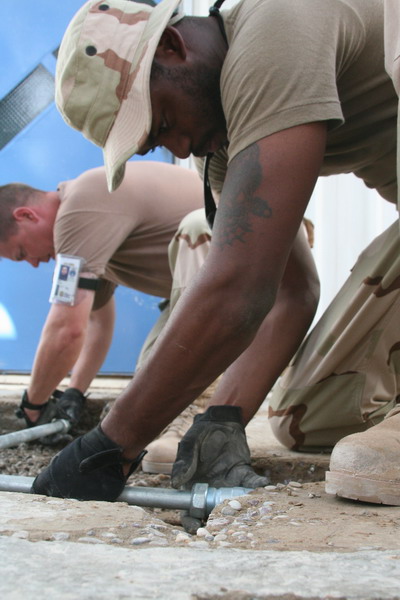
This is a picture of the infamous camel spider. It has gained much ill repute from a number of urban legends, including an email hoax that shows a photo of two huge spiders, each the size of a man’s calf, and is accompanied by an alarming note. The sender said his or her friend (or friend of a friend) knew a soldier stationed in Iraq who had said that these spiders could inject a sleeping soldier with anesthetic, then chew out a chunk of flesh. However, a 2004 National Geographic article http://news.nationalgeographic.com/news/2004/06/0629_040629_camelspider.html enlightens us about the truth of these fascinating creatures. However, here are a few more of the myths propagated by the hoax:
“Camel spiders are said to run as fast as 25 miles an hour (40 kilometers an hour), jump six feet (two meters) in the air, and lay their eggs inside a camel’s belly (hence the name camel spider).”
In fact, camel spiders (also known as wind scorpions) aren’t even spiders (although they are in the 8-legged arachnid family). They’re actually solpugids, or solifugids and don’t have any venom glands. The largest species are 6-8 inches long (the one below is about 4 inches). Also, they are fast, but often are only running to seek shade from the blistering desert sun. When I got close for the picture, this one wanted to run into my shadow.
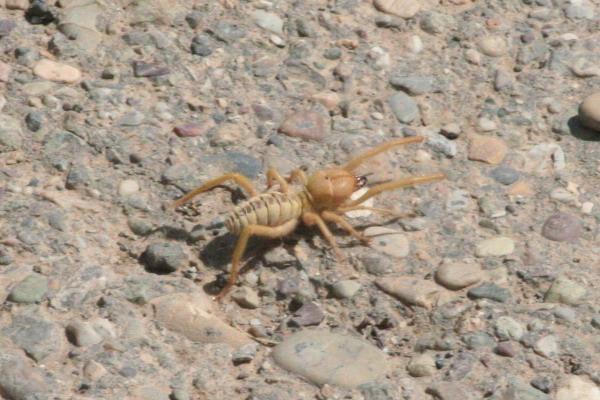
This fledgling barn owl was adorable and we relocated him to another part of the base where he could learn to fly away from people (he kept running into things as he flew around).
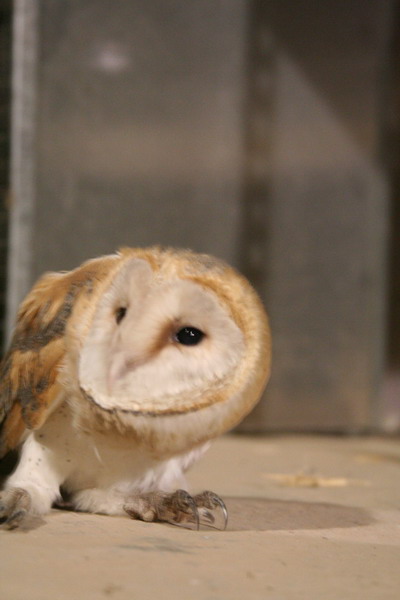
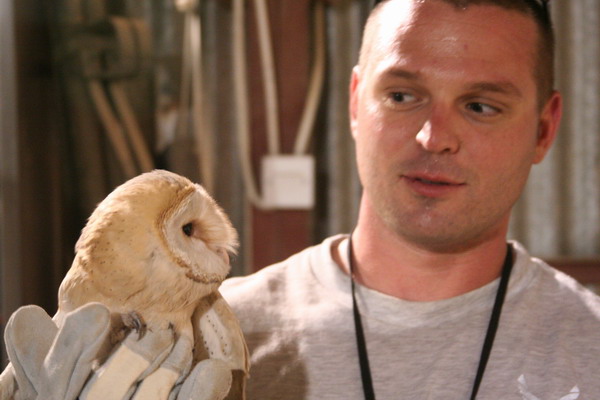
Well, that about sums up things that have been happening over the last 4 months. Of course, I’m always happy to explain further. Please feel free to leave a comment/question and I will email a response.
–Jim
Iraq — having fun
This post will be about some of the activities we’ve done to relax.
While going out to dinner, or playing a round of golf is outside the realm of possibility, there are plenty of things to do.
Quite honestly, the two most popular activities here are watching movies and playing video games. While I am not a fan of the later, I have watched a couple movies in my limited free time. Here are some images from events that have kept the base entertained.
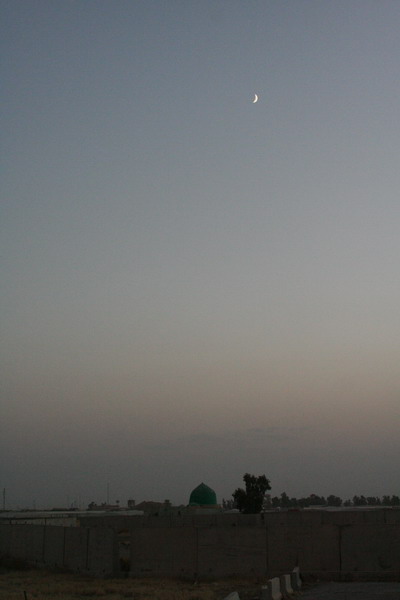
Perhaps you’ve heard of Amateur Night at the Apollo in New York. Well, we had a similar talent show here. A lot of courageous people got in front of a large audience and showed off their skills. The Apollo’s trademark is “Where stars are born and legends are made,” and although there were no big-time producers in the audience, there were plenty of stars in the making.
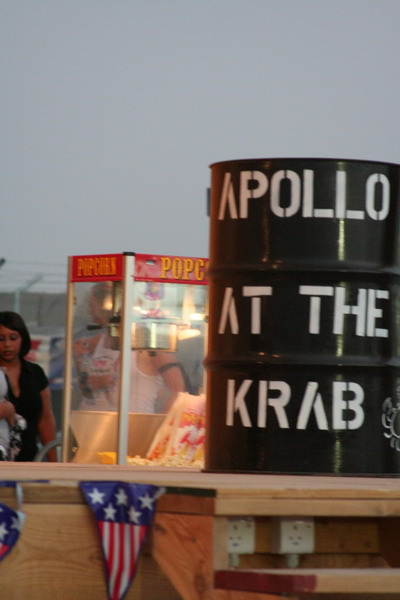
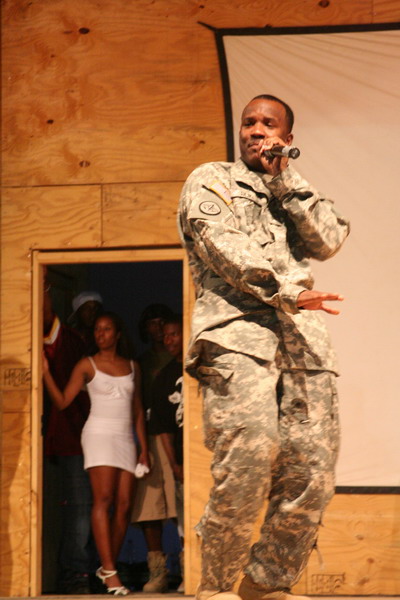
This trumpeter is an amazing musician.
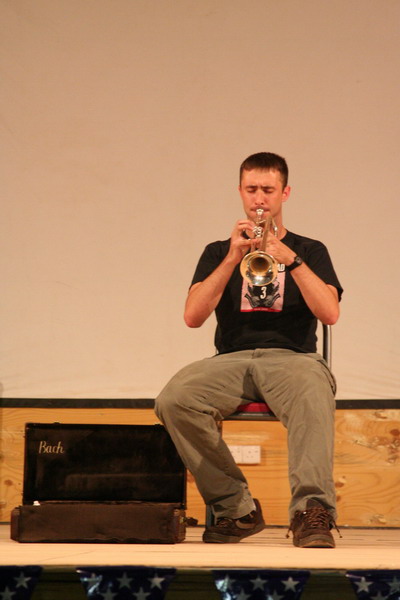
I know this guy looks a little funny here, but he was actually a very talented break dancer.
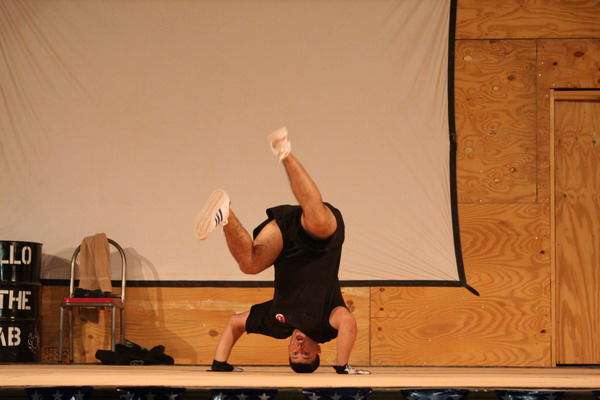
My guys also finished building this stage. As you can see, we didn’t wait until it was completed before using it as a venue for concerts.
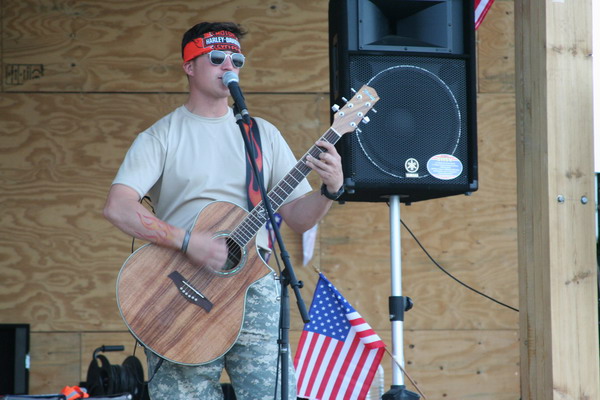
The fire department invited us out for a barrel competition. As you can see, it’s a two-person team that uses the fire hose to push a barrel to one side or the other.
It’s a deceptively simple concept: use a hose to push a barrel past the other team. However, the water really obscures your vision, and the water pressure makes the hose come alive.
When it was my turn to go, I managed to keep the barrel in the middle for about… 30 seconds. Oh well, it was fun nonetheless.
September 18th, 2007 will be the 60th anniversary of the US Air Force. To celebrate this occaision, our base decided to have a number of events. That has included a flag raising, a series of lectures on historic events in our service’s short history and a series of athletic competitions.
The pictures below are from the base photographer, who documented the competition.
The first event was a game of elementary-school-style kickball. The teams were broken up roughly by rank. So my teammates were company grade officers (lieutenants and captains). Surprisingly, we remembered how to play pretty well and actually won the event.
This is me sending the ball on a little ride.
The next event was the formidable dizzy bat.
You can see here that I had the job of counting revolutions as people spun around the bat. Also, I tried to help people from falling too hard on the rock hard ground.
Then, it was my turn. I really didn’t want to go (not a big fan of spinning around in circles), but my team pleaded that we didn’t have enough people to compete. So, I acquiesced.
As expected, it was a little tough to run in a straight line. In fact, I was barely able to stay on my feet! But, somehow managed to get through to the finish line.
Unfortunately, one of my teammates, Tyler wasn’t able to keep his footing. At least he was still smiling. 🙂 Unfortunately, we weren’t quite fast enough to win this event.
Our Army brethren also joined in on the fun.
The next event was a mental challenge. We competed in a lively game of trivial pursuit, where we tied for the win with a question about which country had a sword and shield program that taught young children how to fire AK-47s (answer: the Soviet Union).
However, following the mental strain, we decided to revert back to athletic competition with a sprint triathlon. I tried to be the organizer, race director and competitor. Let’s just say the event gave me new found appreciation for my friends on Guam who do that all the time. I had helped, but never ran one myself. I was glad to do it, but it certainly was a challenge. Oh, and this was at night, so I had already worked outside all day setting up the tents you saw in the last post. By the end, I was completely wiped out. But, it was still fun.
Vince Vaughn and Ben Stiller have done much to bring dodgeball back to the mainstream. However, the company grade officers proved we had much to learn about the sport, since we finished dead last in this event.
The last athletic competition was a 10K race. This one was different from all the others and started before sunrise. It was a perfect morning for a run.
Jake and I ran most of the race together. I’ve found it’s much more fun to talk and run with someone else, than in silence by yourself (since we can’t wear headphones outside).
After each event, my team joined me here for a BBQ and social gathering. It’s nice to be able to hang out with peers and just relax.
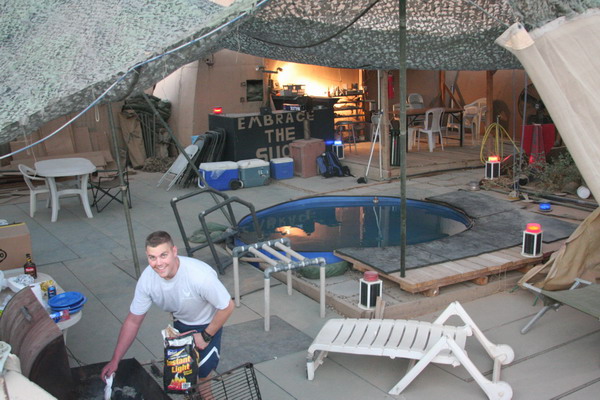
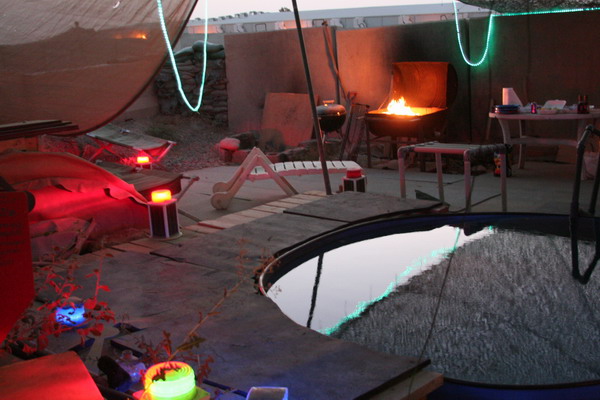
So, those are a few of the things I’ve done to relax and enjoy my time more here.
–Jim
Iraq — day to day, part 1
Well, I have now been in Iraq for 4 months. I’ve seen beauty and ugliness here. However, the experience has been very rewarding and overall a very positive one. In a few short weeks, I will be home in Germany.
Below are some images from my time here.
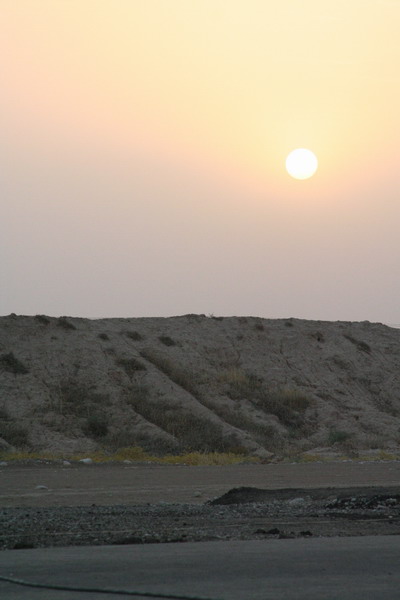
If you think this plane looks small, it is. This is a UAV the Army flies here.
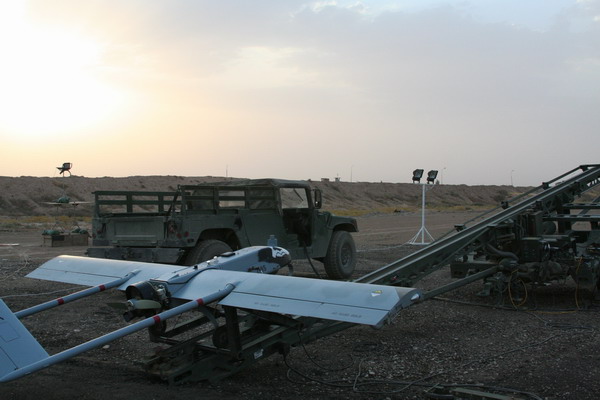
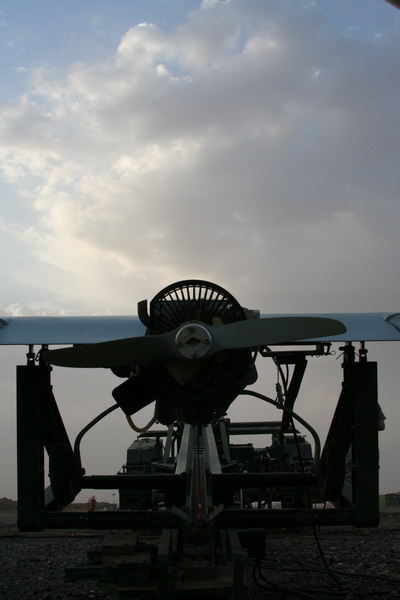
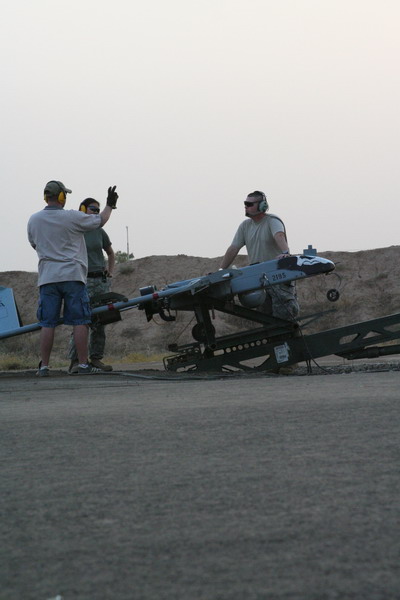
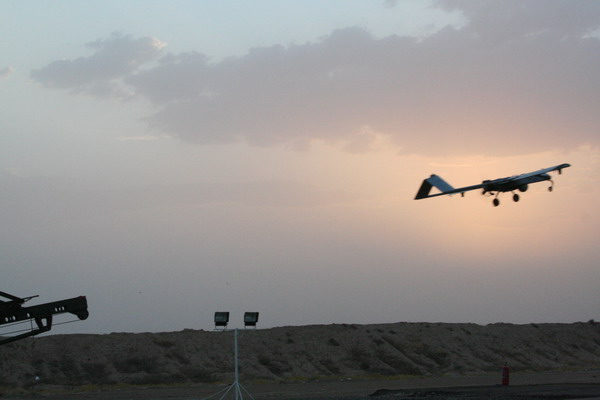
As you can imagine, our explosive experts capture a lot of weapons. These can be used against us, so to eliminate that threat, we confiscate and dispose of them. Below are some pictures of that disposal process.
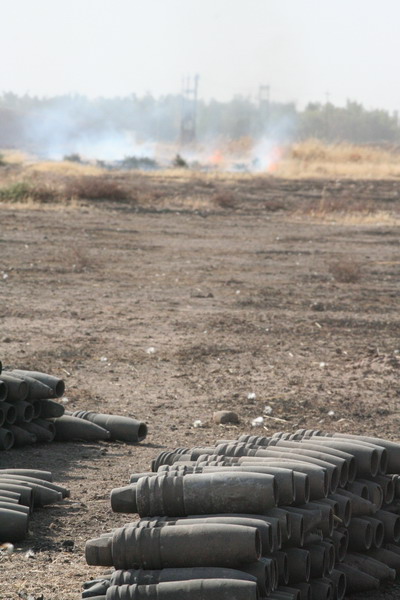
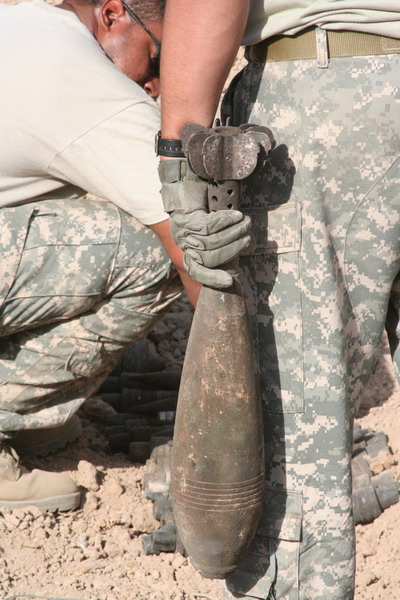
You can see the C-4 (in the green plastic) that is used to detonate the explosion. Also, below are unserviceable US hand grenades. In this case, some parts have corroded and it’s safer to blow them up, then ship them home. If you’ve been reading my blog for a while, you’ll remember that we did something similar with old bombs on Guam.
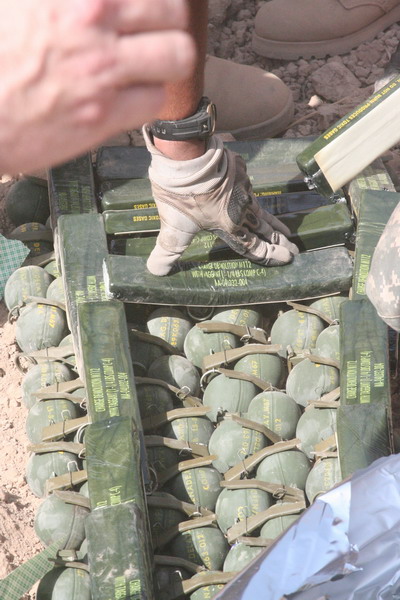
Here’s the pit, ready to blow.
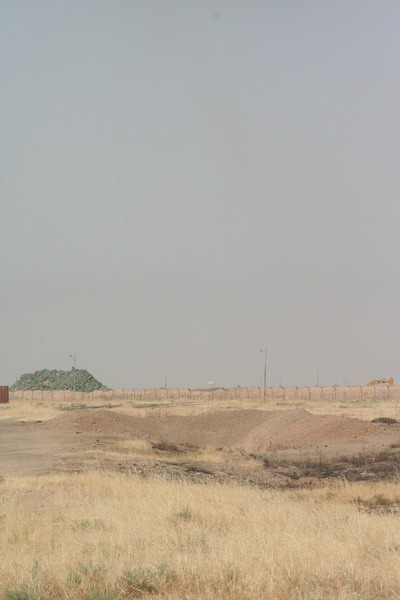
Fire in the hole!
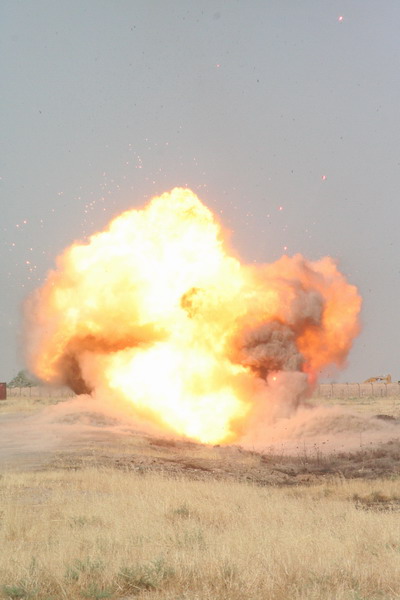
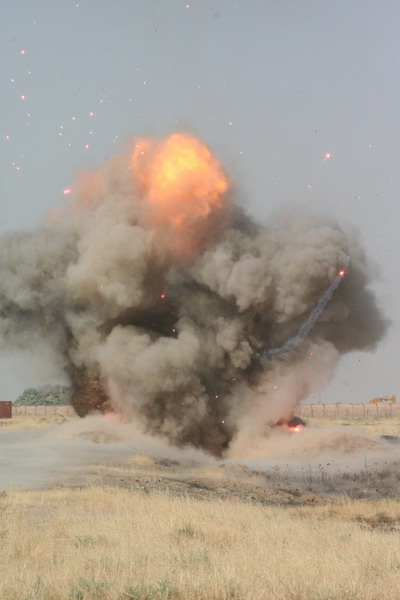
It seems that scorpions are attracted to me (or me to them). I have seen a whole bunch of them here… in my office, bedroom, on the road, and now, right next to an active explosive ordinance disposal site.
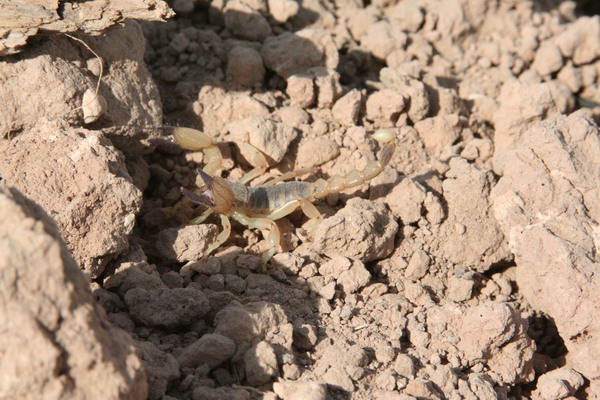
Disclaimer: I did not take the rest of the pictures on this post (they came from either the base photographer or the public affairs chief).
We have done a lot of concrete work here. The Airmen in the shop responsible for placing all that concrete are affectionately knows as Dirt Boys. Officially, however, they are heavy equipment operators. For larger projects like this one, they enlist the help of other volunteers to finish quickly. In the heat of the desert, concrete dries very fast.
Trivia: a common misconception is that concrete and cement are synonymous. That is only partially true, concrete is cement, but cement is not concrete. Cement is actually a component of concrete that when mixed with sand, water and gravel forms that familiar hard building material.
As you can see, the Dirt Boys took any help, including my unskilled labor.
There are very unique animals here. This majestic cat is known as a Jungle Cat or Felis chaus. Jungle cat is an interesting name, since it is found in Egypt, West Asia, India, Sri Lanka and Southeast Asia, but nowhere near a rain forest (I can attest that there is nothing remotely like a jungle in this area). It is only slightly larger than a domestic cat, but has a relatively short tail. So, it’s name notwithstanding, the entomologists (not to be confused with etymologists) catch these cats from time to time and relocate them to another place on the base. They are certainly not dangerous to humans, but ideally we try to limit their contact with us.
This next group of pictures is from a big event we had to raise large, living tents on base. As you can see, they are rather complicated to assemble. So, we used one or two craftsmen with a group of volunteers to erect the tents.
Rolling the rain fly to get it ready for installation.
Putting the wall sections on.
One, two, three… up!
Then, inside to check all the safety pins are inserted.
It was a long, hot day and a little Flavor Ice tasted good.
So, that concludes this first part. Hopefully, you have a little better idea what day to day life is like on the base.
–Jim
Blondie in India- Part 2
When the rain started, it didn’t stop for the rest of the two plus weeks I was there. Rainy season in India is nothing to scoff at, there were numerous times when I couldn’t sleep at night because I was afraid that the roof would blow off! It was nonstop for about a week, and then started to go into a three day cycle. There were three days of nonstop rain, followed by a morning of sunshine, then back into the rain. As a result, there was very inconsistent power, and of course I forgot to bring a flashlight. So going outside to use the bathroom in the middle of the night was more of an ordeal than it should be. Since the rain refused to stop, our clothes also refused to dry. By the end of the last week, everyone was walking around with moldy, stinky clothes and most had just given up the attempt to clean their clothes. The great thing about rainy season is that within the two weeks that the rain started, everything started to grow like crazy and the landscape changed dramatically.
Here is a photo of people in the field across the road from the ashram picking rice. Notice how the palm tree is having a hard time staying upright. This was a mild day.
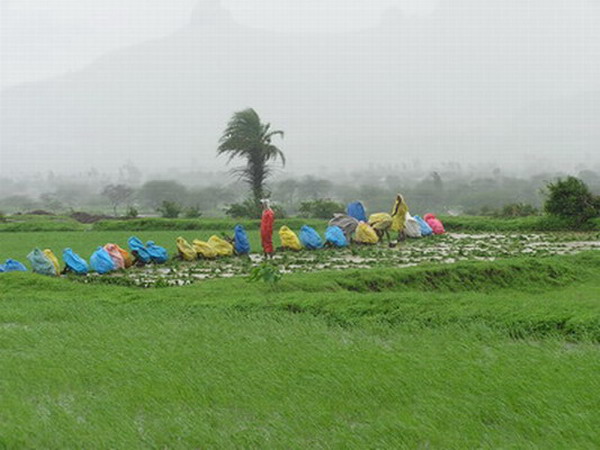
Here are some pictures of the same landscape that was dry and brown just a week prior.
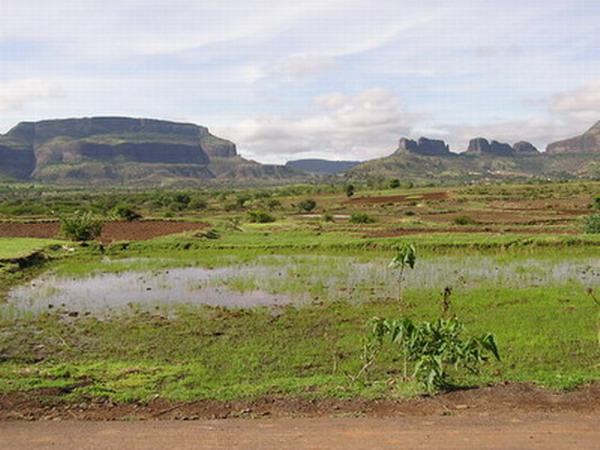
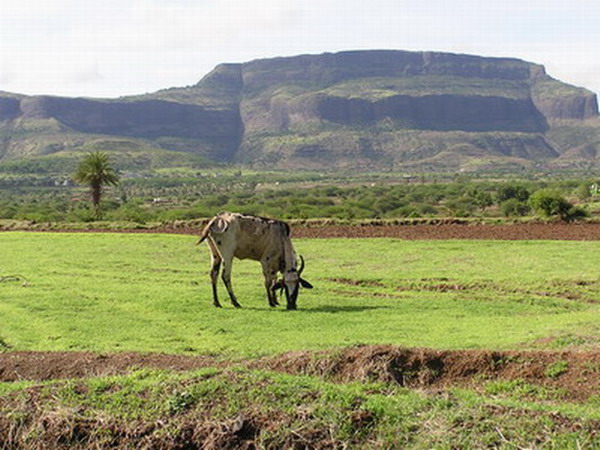
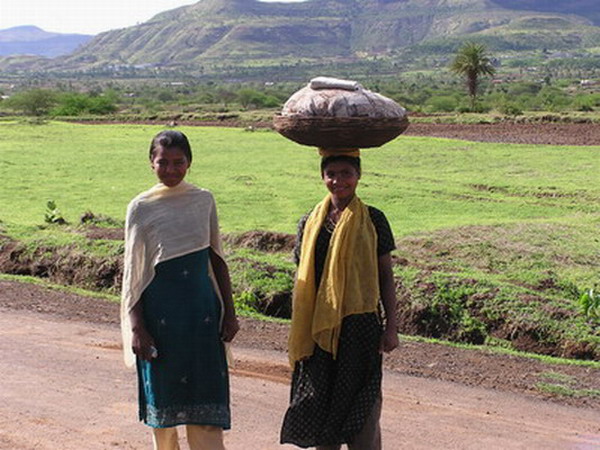
These are some women from the local village who were making use of the abundant rain water by washing their clothes in the puddles on the street.
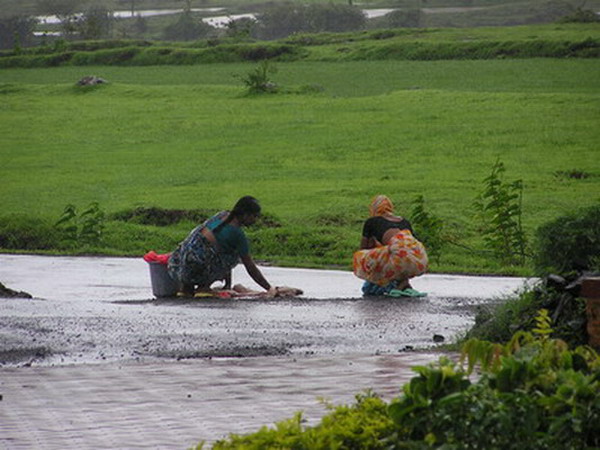
When people go through a rough situation it tends to bring them closer faster and this was the case at the ashram. Here are some of my new friends.

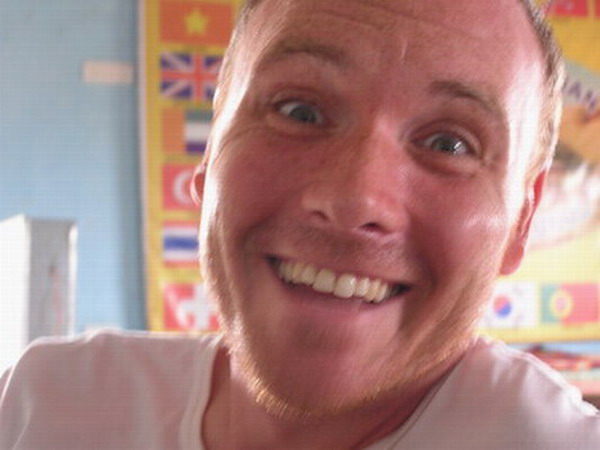
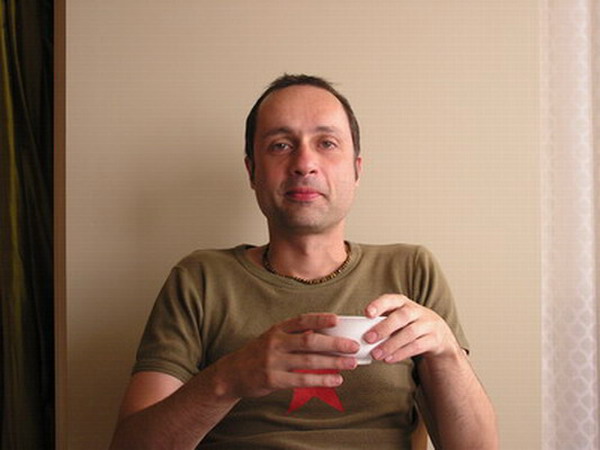
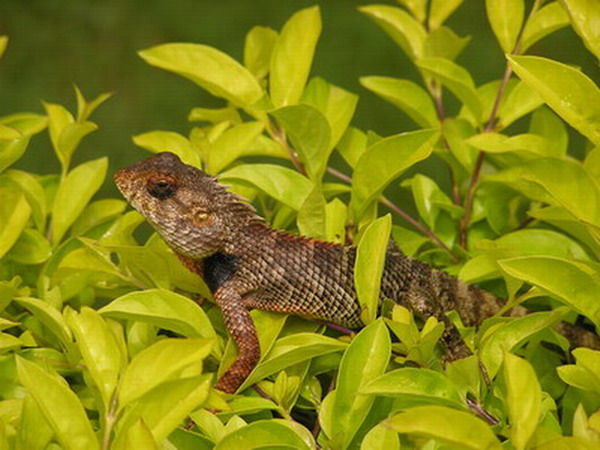
Considering the fact that there were 4 women sharing the same room for a month, I think we got along quite well. These are my awesome roommates.
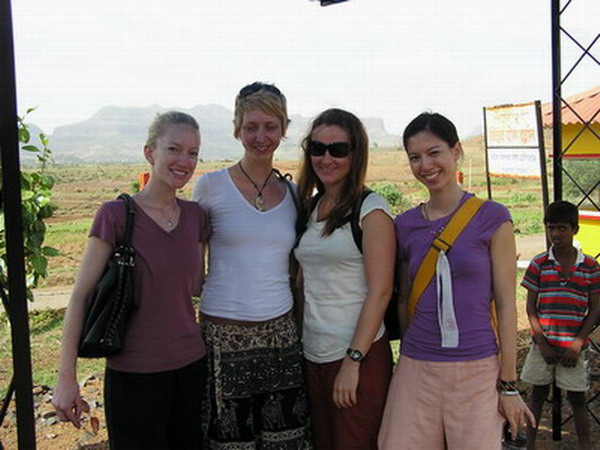
This is a view of the inside of our room.
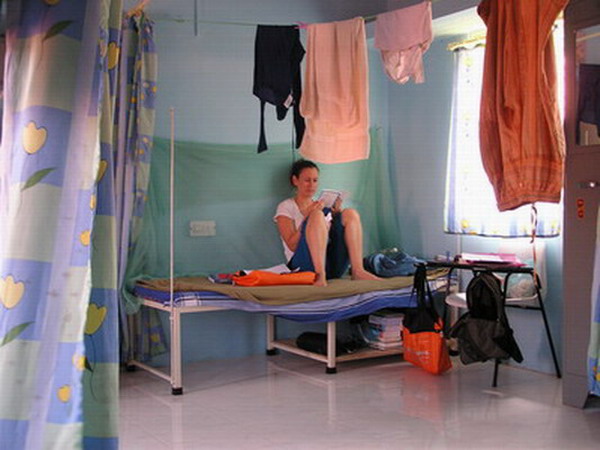
Below, you can see I took pictures of typical meals at the ashram to give you a better idea of the whole Ashram experience. The food was a sattvic diet, which is the traditional yogic diet. It is meant to not over stimulate the senses. Thus there was no garlic, onions, nor too many spices. The only real spices they seemed to use were turmeric (and lots of it), mustard seed, lots of salt, and cilantro. These few spices are great, but when used for every meal, three times a day, for an entire month, they get to be a bit much. As a matter of comparison, when I finally ate outside of the ashram (after 3 weeks of this strict diet), I ate garlic naan (garlic flat bread), as well as numerous other spices. Consequently, I felt more energetic with better mental capacity than I had in weeks. Regardless of whether it actually made a difference or not, if I never see another potato curry for the rest of my life, that will be fine with me.
Breakfast:
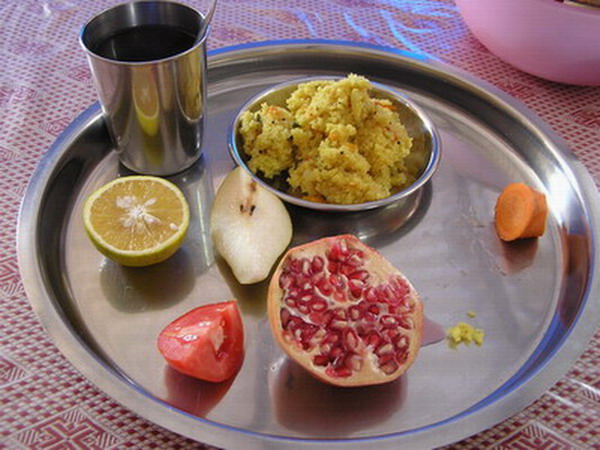
Lunch:
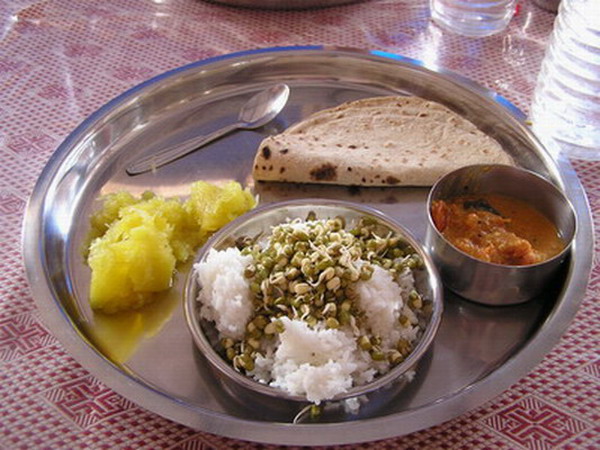
Dinner:
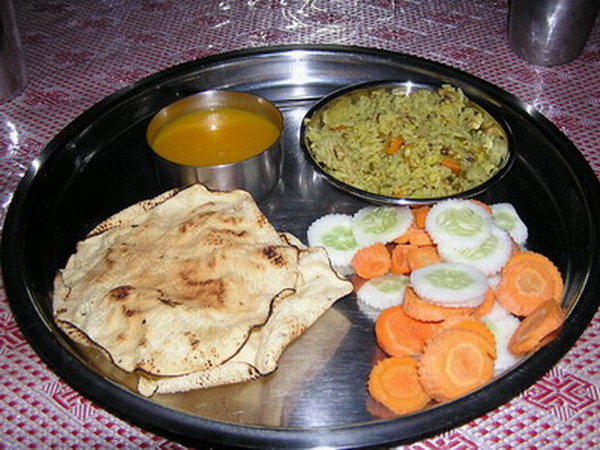
There were numerous cleansing processes that we learned while at the ashram. One is the neti pot. This is where you insert a sort of tea pot with a long spout, filled with salt water, into one nostril. The water goes through your nasal cavity, cleaning it out, and comes out on the other side. Surprisingly, we were actually graded on this process and how constant the stream of water was coming out the nostril!
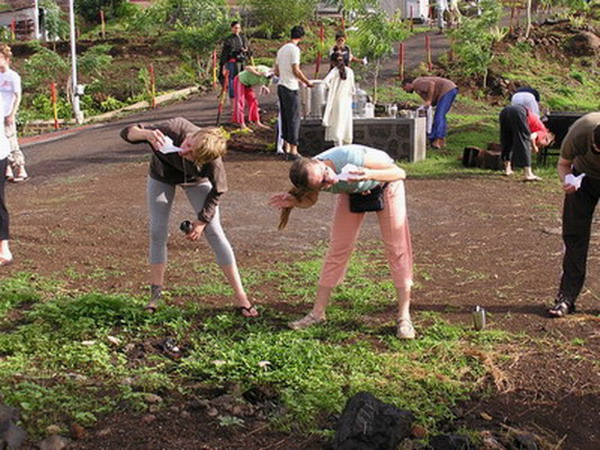
Another cleansing process involved drinking 4-6 glasses of salted warm water, and then vomiting it back up. Sounds like fun, huh? This is done to clean out the mucus that accumulates in your stomach and esophagus. It was one of the more unusual practices that they did at the ashram. I wanted to have the original yoga taught to me, right? Well, here is example of how you should be careful what you ask for. This is one of the many cleansing processes talked about in Hatha Yoga. So, I joined my fellow classmates in drinking saltwater, but only made it to 2 glasses before I couldn’t handle it anymore. This “cleansing” process was definitely an interesting experience that I will not easily forget.
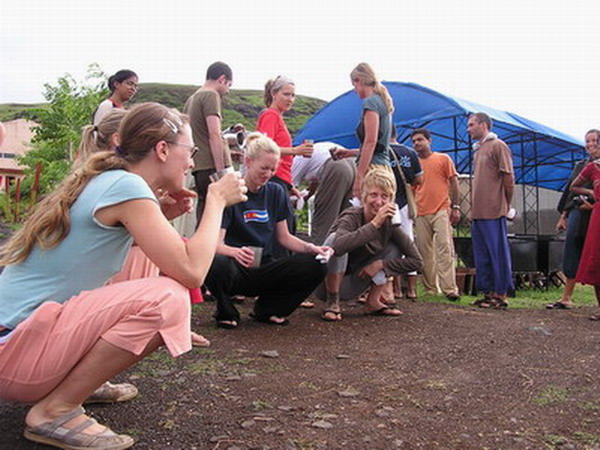
Here is my friend, Katie, trying to get the salt water back up. Sorry to any of you who have a weak stomach.
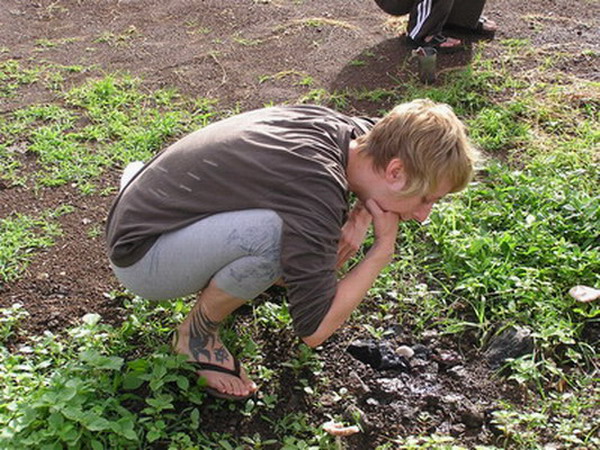
Another advanced cleansing process, which I did not do, involves sticking a tube through your nostril and then pushing it in until it comes out through your mouth. This process is demonstrated here by one of the advanced students.
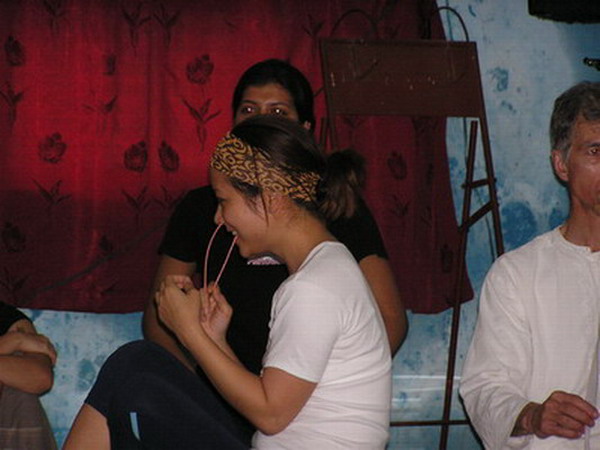
Yoga gymnasts.
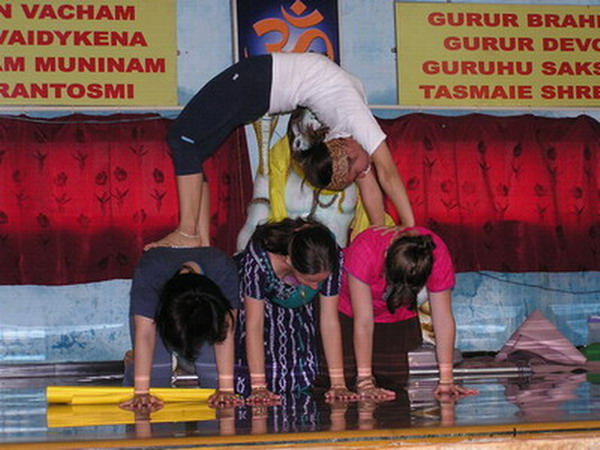
This is the guru of the ashram, Guruji. He, his wife, and son all wore the typical saffron colored robes at all times. This indicates their high status and understanding of yoga.
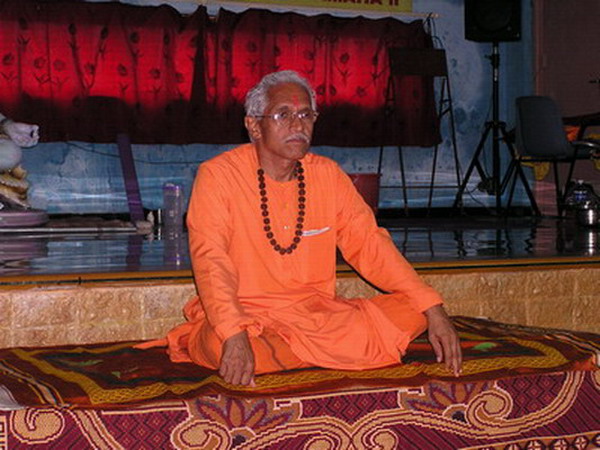
This is his wife, whom we all called Mama Guruji because we couldn’t remember her real name. She has an amazing singing voice and here she is singing the opening prayer for us.
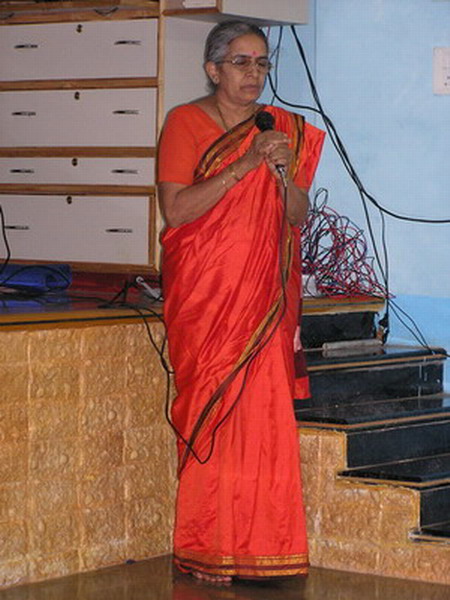
Here is Gandharji standing next to me. Strangely enough, after a month of not eating much and losing more weight than I ever imagined I would, he still makes me look big.
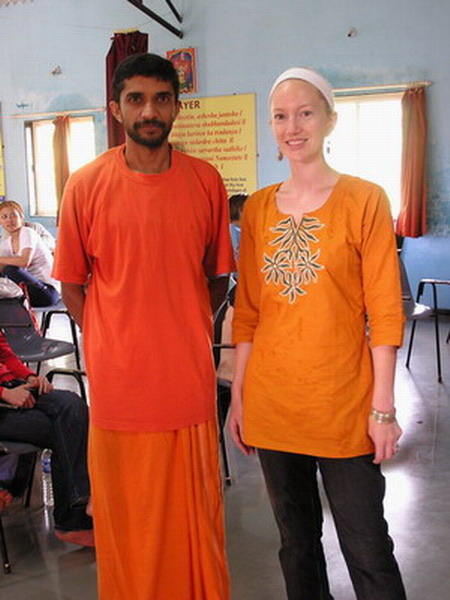
This is the person, Ananji, who ran the shop where we could by most of the items that one might need while at the ashram, soap, t-shirts, books, cookies, what have you. He was always smiling like he knew something we didn’t. I wonder what it was?
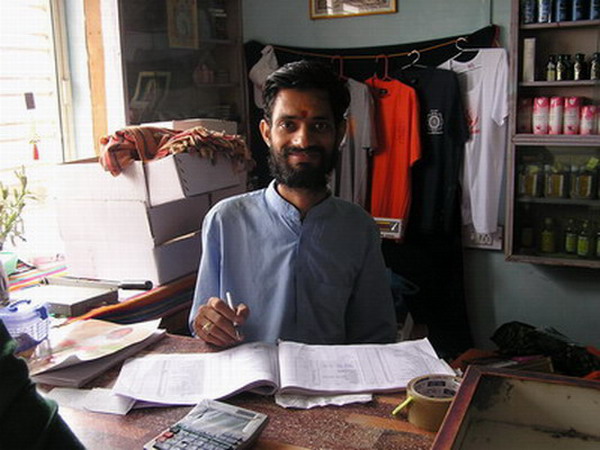
This is a photo of the statue of Lord Shiva that sat in the front of the yoga hall. Every morning we would chant for about a half hour and most of those mantras that we chanted were to Lord Shiva. It was a bit disconcerting to me that we were worshiping a figure with blue skin and looked like a transvestite, so I stopped going to these chanting sessions in the end (plus, I wasn’t looking for a new religion). Shiva is one of the three gods in the Hindu religion, along with Brahma and Vishnu. I didn’t want to be disrespectful to the Hindu religion by not attending chanting or making fun of Shiva, but come on … a blue transvestite??
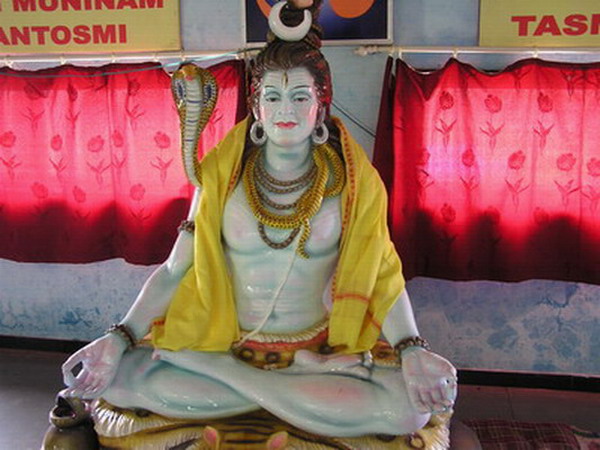
On the last weekly day off I decided to go to another town nearby, Trimbuk, which holds one of the twelve most holy temples in all of India. Unfortunately cameras are not allowed into the temple walls, nor are non-Hindu people, usually. But, this temple allowed me and my friends inside, sans cameras. I managed to get a shot of it from the outside.
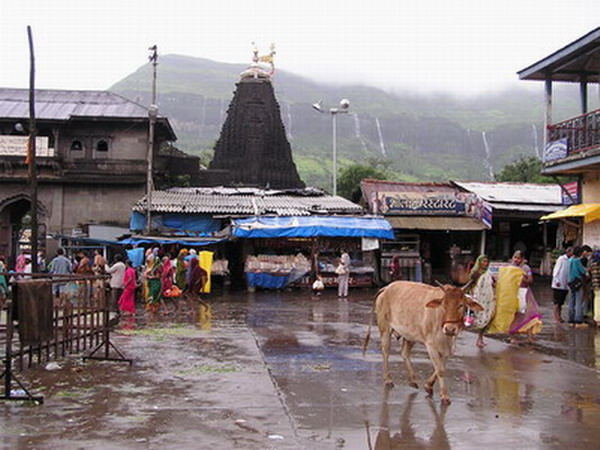
Some of the local people.
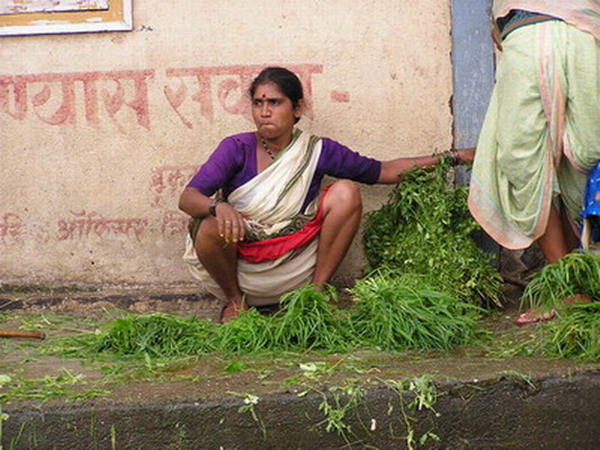
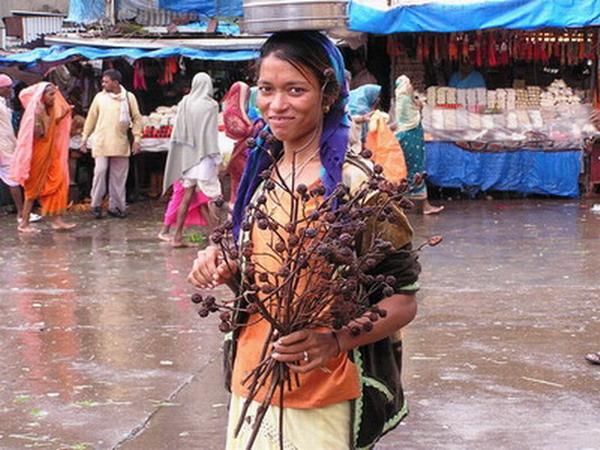
On the very last day there was a talent show held at night. Here are the announcers of the evening, Jeff, Katie, and Chris, showing off their OM chanting skills in their new “Supermantra” t-shirts.
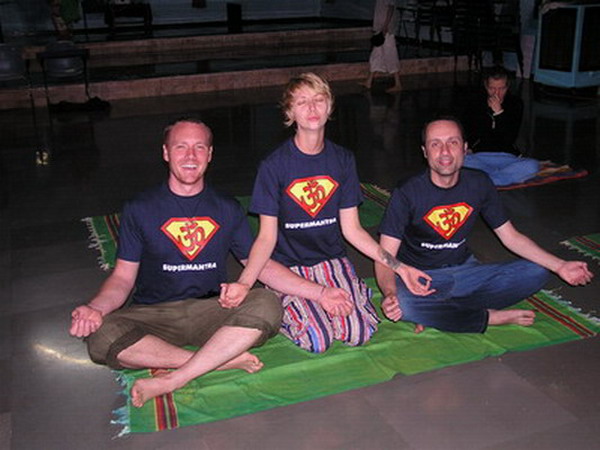
When the month was finally over, some friends and I decided to stay at the Taj Mahal Palace in Mumbai for a night, just to enjoy some opulence as a contrast to the basic living we had been doing for the past month.
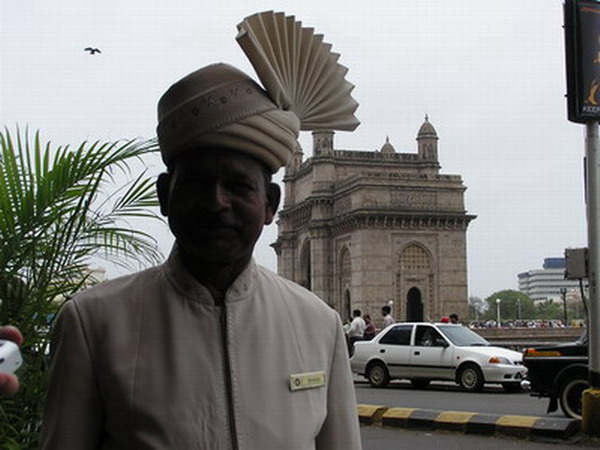
The Taj Mahal Palace is one of the nicest, if not the nicest, hotels in India. The price is insanely high, but it was worth it. This is the view of the Gateway of India taken from our hotel window. The Gateway of India is the most widely recognized landmark of Mumbai, built in 1911 to welcome King George V and Queen Mary to Mumbai. This gateway is traditionally the first thing that people see when arriving by ship via the Arabian Sea to Mumbai. It is also located in the nicest areas of Mumbai, Colaba. So a night at the Taj served to balance us out with the extreme opposite to ashram living. Then we were ready to continue normal life.

On my last day in India I decided to get a henna tattoo. This was an interesting experience and I thoroughly enjoyed getting a henna tattoo. It was much more pleasant than an ink tattoo. No pain required! Traditionally henna tattoos are applied on women’s hands for their wedding days or for a special occasion. Henna is applied like icing put on a cake. It comes in a cone, and the tip of the cone is cut off. The person applying the henna proceeds to draw on your hands with the henna icing. There are stencils available, but the person who did mine did it freestyle and was finished with both hands within a half hour. It was amazing to watch. There is so much skill and precision involved. Then I had to sit with my hands up in the air and not touch anything for at least an hour, which you can imagine was quite difficult. Amazingly, I succeeded in not smudging the henna, and this is the result:
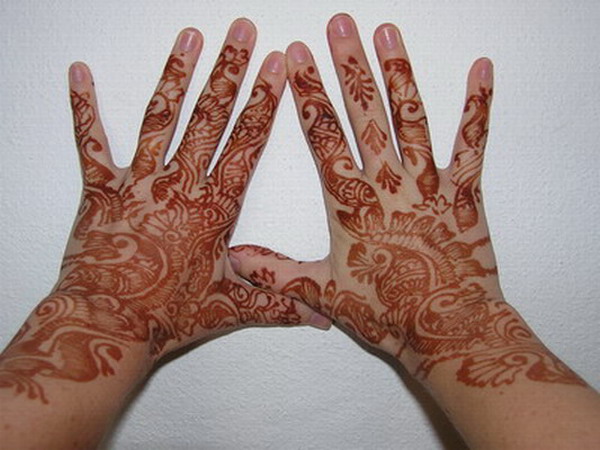
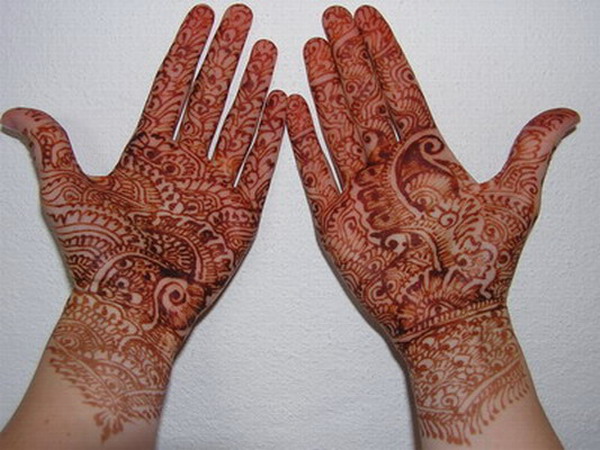
For my last photo I will leave you with a simple impression that is so very India.
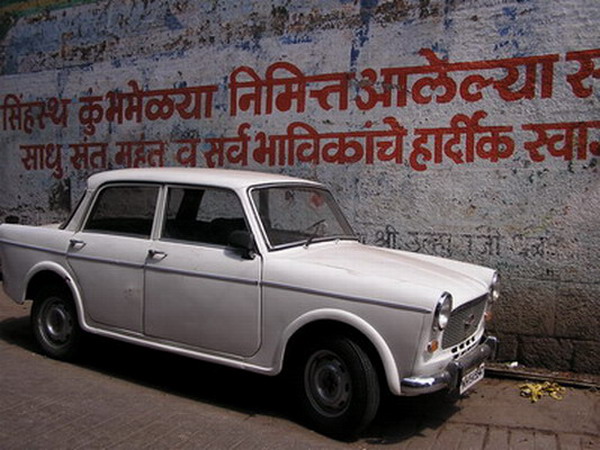
I learned so much while I was India that I hope never to forget. One such lesson is that we in the west, and America especially, live a very blessed life. We eat every day as much as we want, have shelter over our heads, have running, hot water showers, and have the ability to reach all of our goals by hard work and determination. In India, this Horatio Alger dream is not there. There is such an acceptance of social class structure (read: caste system) that there is no way out of the social class that you were born into. It is just accepted. Being a female in India is similarly difficult, and it really made me appreciate the giant steps forward that our western society has made through the sacrifices of our mothers and mothers’ mothers for our sake. I knew this information before I went to India, but to see the way that people live and the way that certain people are treated, it really hit home that I am incredibly blessed. It made me truly grateful for what I do have and made me more at peace with what I don’t have (which, admittedly, isn’t much). I have seen poverty and desperation before, but nothing compared to India. It drove home the idea that I really should be grateful for what I have right now, more than any other place I have visited before.
The ashram itself gave me a lot of new experiences that I can honestly say I will never have again. For example, the stomach cleansing process was one I hope to never repeat in my life, but now I can say I have done it. This kind of group experience, vomiting together, made us all a very cohesive yoga team and I have made some great friends that I hope I will keep in touch with. When you go through tough times with people it certainly makes you bond a lot quicker and longer. My thoughts of the ashram will forever be linked with the friends I made there to a greater extent than the actual yoga.
Interestingly, the more I learn about various religions, the more I realize at the core, all religions want to achieve the same thing. They just use different methods and terminology to get to that same “place of higher understanding.” Truly when it comes down to it, we are all so incredibly similar and the differences that keep us feeling so separated from others are all just a matter of semantics. When I realized this in India, it was a lot easier to communicate with people and feel safer in a country that before seemed so aggressive and unwelcoming. It led me to much better interactions with people. I stopped expecting misunderstanding, even though it seemed there was a vast cultural gap between us.
I will treasure my experience in India forever, and I thank you for reliving my journey with me.
Hari Om,
Anna
Blondie in India- Part 1
Ah India, where to start? Unfortunately all of my pictures from the first 5 days that I was in Mumbai by myself were lost. So I don’t have any pictorial evidence of being there, but please believe that this was the hardest time that I spent in India. I was constantly bombarded with people, mostly children, begging for 5 rupees which is approximately 10 American cents. I have never been faced with amount of poverty that I saw in Mumbai. From the minute I got off the plane, there were hoards of people around me at all times asking for money or just staring at me. There are very few western people in India to begin with, and a blond American female traveling by herself is an extreme rarity. So I was the receiver of much unwanted attention. While traveling, people would reach out to touch me as I was walking by or even in the car. I am assuming it was just to see if I was real, but it was quite unnerving at first. It took me quite a few days to get used to that level of attention from everyone.
Also quite prevalent is the idea that since I am a westerner, I must have money coming out of my ears. So every person I ran into seemed to want either baksheesh (tips or handouts) or charge about 3 times too much for the goods they were trying to sell me. As I did most of my shopping in the 5 days that I was on my own, I got quite good at bargaining with people. Although I usually ended up spending a bit more than an Indian would, both parties were usually happy with the transaction. In between shopping trips I went to a couple tourist attractions, such as Elephanta Island, which in true Indian fashion holds nothing even resembling an elephant anywhere on the island.
I learned quite a few things about Indian culture during my short time on my own. One is, if a woman makes eye contact with a man that means she must be looking for a good time. Another is that if you are a blond female, they assume you are looking for a good time whether you look at them or not. I attempted to blend in at first by wearing some Indian clothes that covered my shoulders and showed no leg, but that didn’t seem to change anything. So finally I just accepted the fact that everyone was going to stare. Then I became a lot happier with the whole situation.
When I finally was becoming more comfortable with Mumbai and all the chaos that was involved there, it was time to go to the ashram. I was glad to be starting my adventure in yoga.
Here is a picture I took from the bus on my way to the ashram. He seemed to me like the James Dean of India.
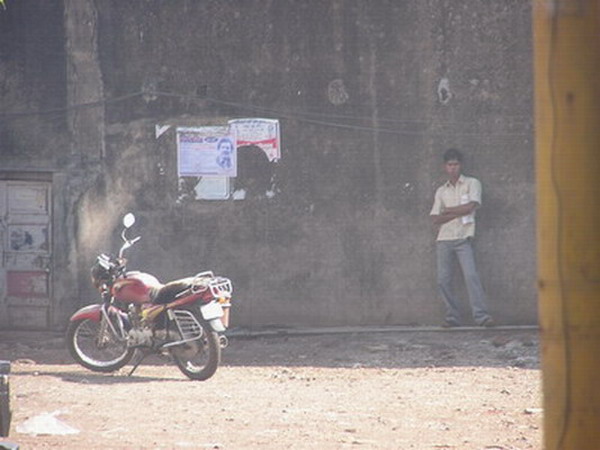
These women were filling bags of dirt by hand to transport to the other side of the road that was being built to dump in a pile. This gives manual labor a whole new meaning.
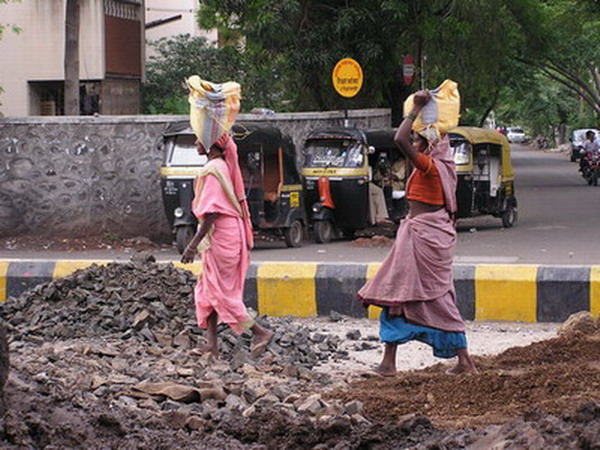
When I finally made it to the ashram after a day of travel, this “OM” sign in Sanskrit on the side of the mountain served as an excellent welcome and entrance into the world of yoga.
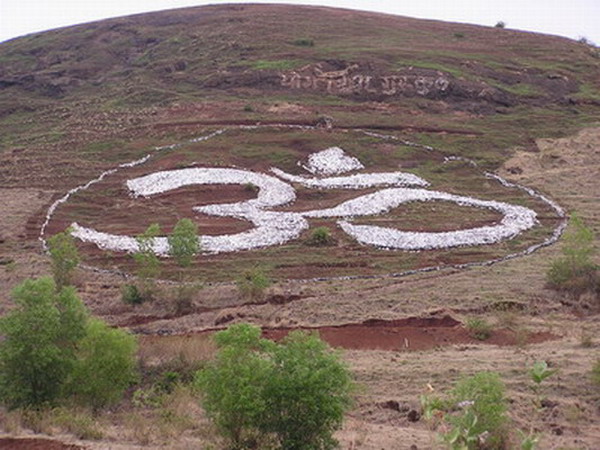
This is the entrance to the ashram.
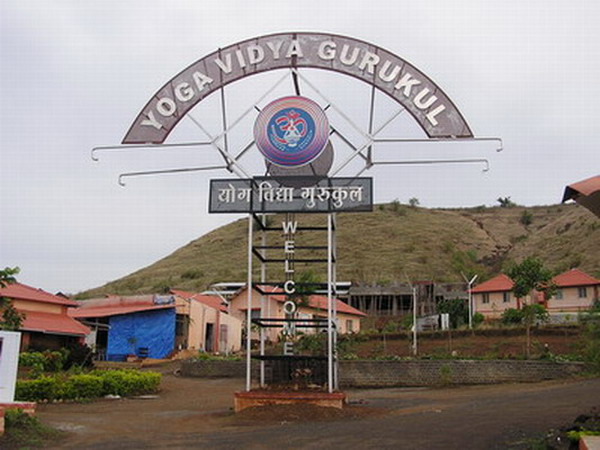
My home for the next month and my new roommate, Natalie.
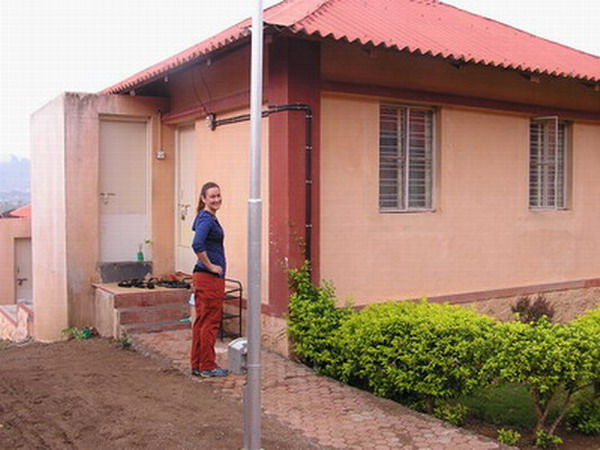
The view from the ashram before the rainy season started.
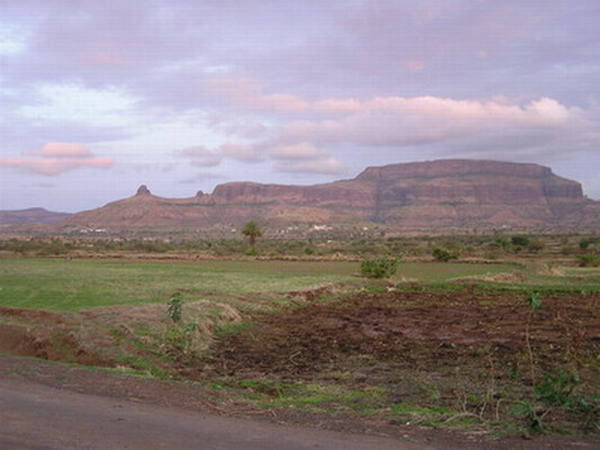
On our first day at the ashram we were given a presentation by some of the people who would be teaching us yoga. Some of them were quite reminiscent of Gumby.
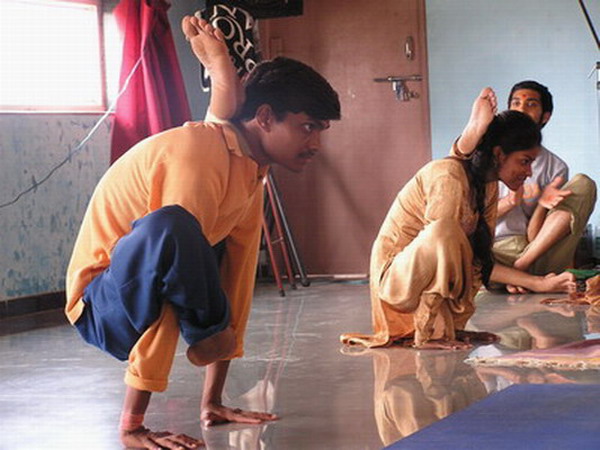
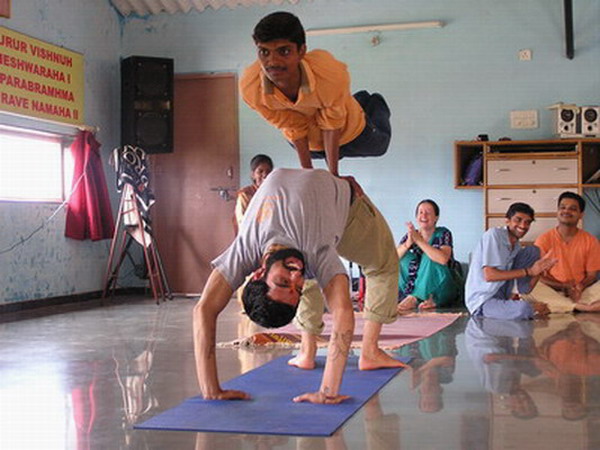
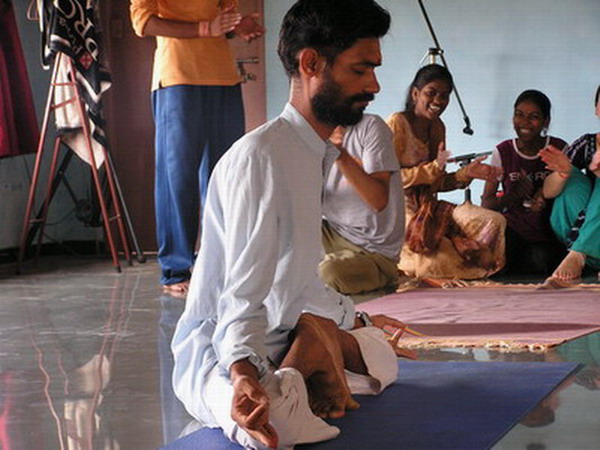
He makes it look so comfortable!
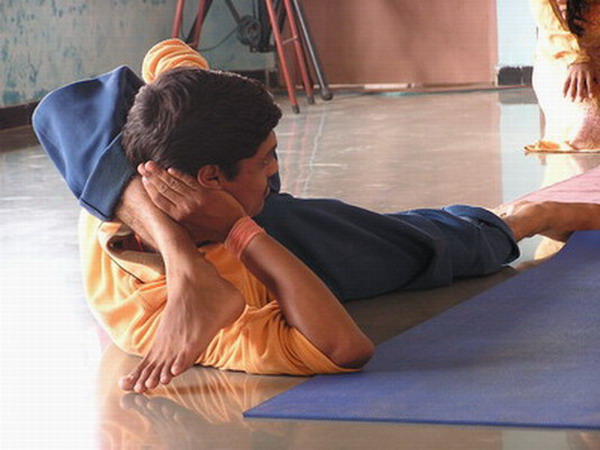
This is Hansraji, a volunteer who had just taken the teacher training course the month previous. I was a bit nervous that we would be expected to perform this asana by the end of the month. Asanas are what most westerners know as yoga. They are the different positions that you attain and hold. The other aspects of yoga which are not commonly taught are pranayama (deep breathing), karma yoga (doing good things without the expectation of reward), meditation, and chanting. All of these things are done for the common goal of attaining Samadhi, or the union of self with the universe. They are just different vehicles used to get to the same place in your understanding.
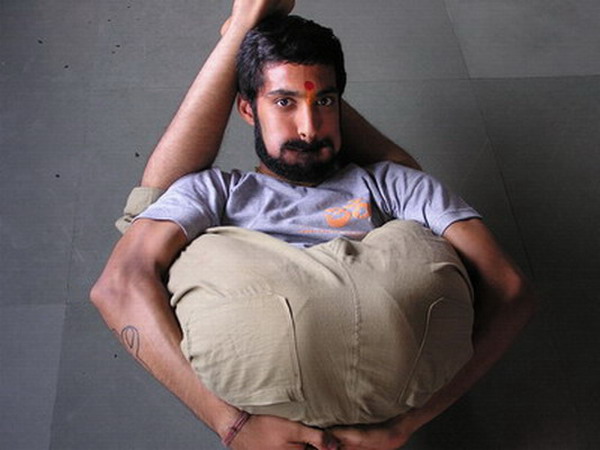
This is Gandhar, our teacher and son of the ashram guru.
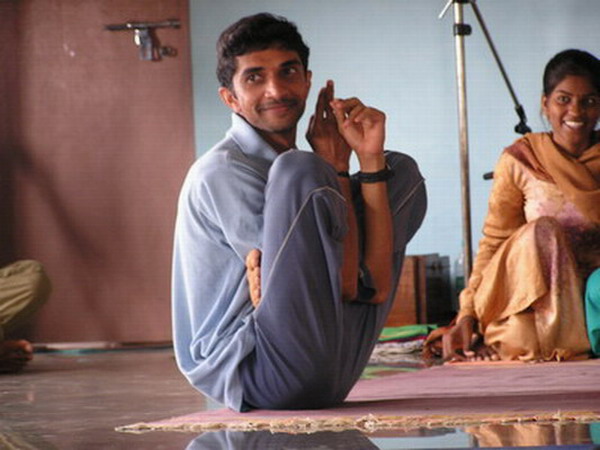
Now it was our turn: Everyone get into a pretzel!
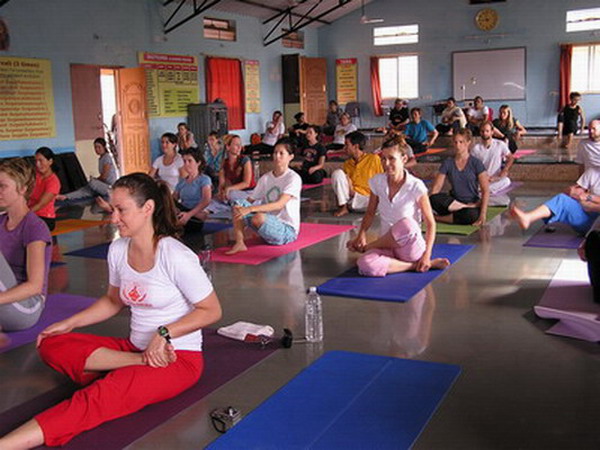
In the first week, a few others and I walked down the street to the small town that was near us. As this was a farming community, we saw plenty of cows and people trying to till their land and get it ready for the rains which were coming soon.
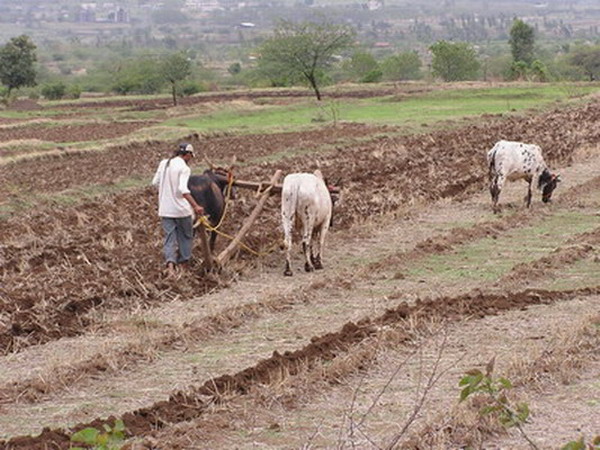
Also, when the neighborhood kids saw us coming, they ran out from their houses and started asking for photos. They do not have cameras and loved being in photos, so we gladly obliged.
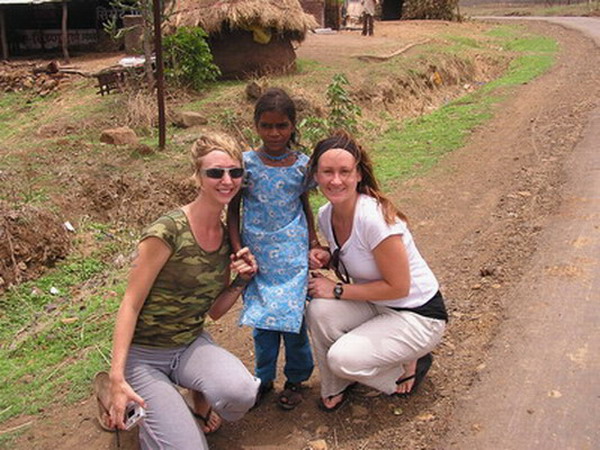
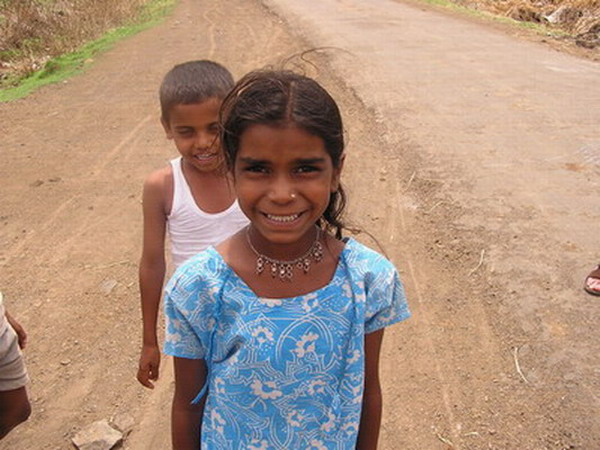
Then they wanted to take the pictures, so I nervously handed over my camera to the girl. To my surprise, she was actually a pretty good photographer.
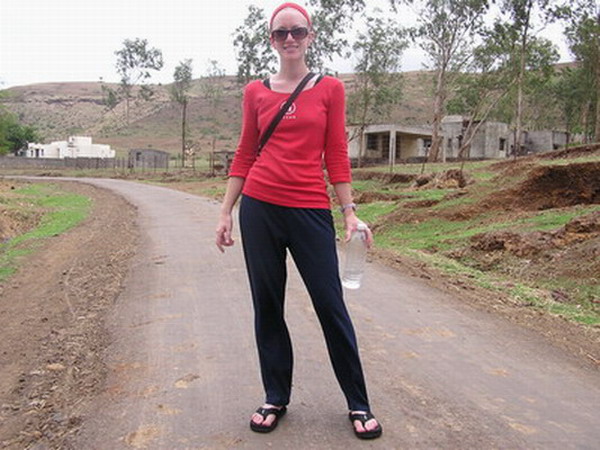
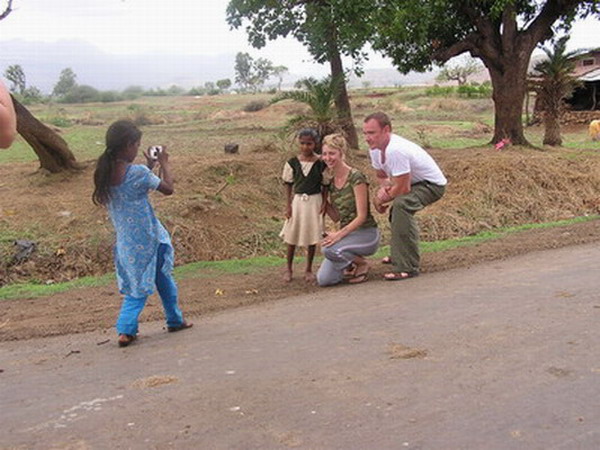
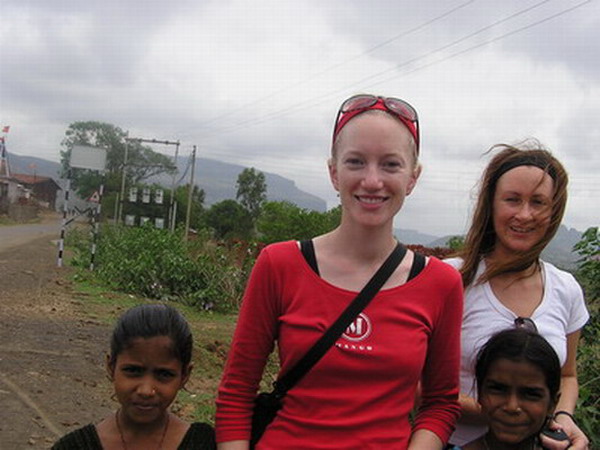
Weekly we would get one day off to go into a nearby city, Nashik, which holds about 1 million people and importantly at least one internet café. We would do a little shopping, internet surfing, and eat some forbidden food, including chocolate, meat, and coffee or tea.
This is what I encountered at the markets.
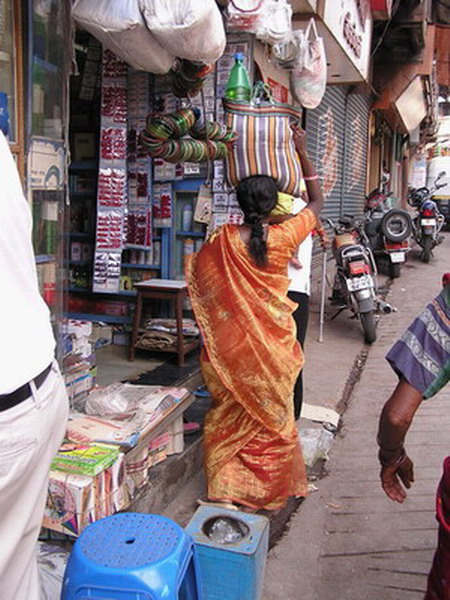
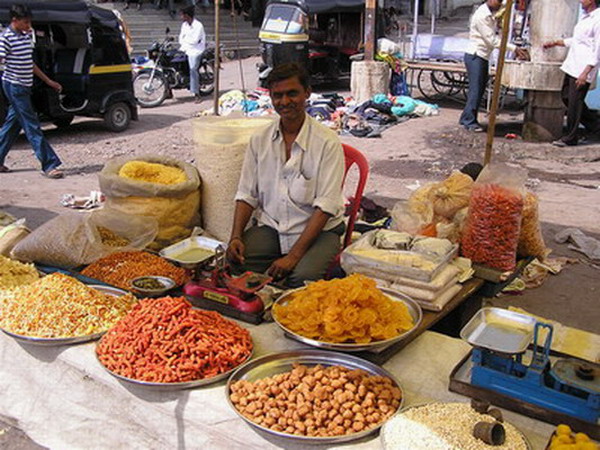
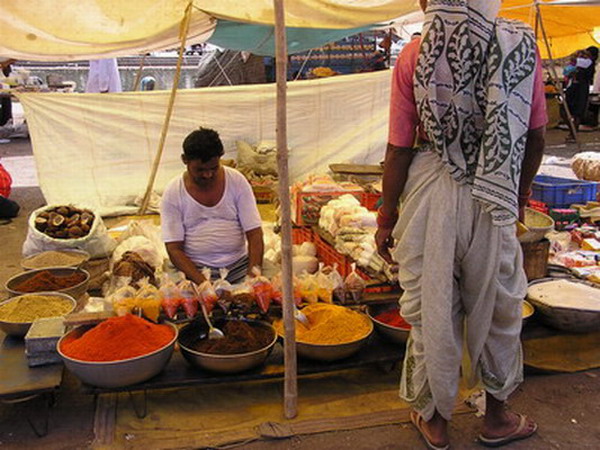

Here is one of the guys I was hanging out with for the day, Jeff. He was trying to get a little sunscreen protection, since the sun was so intense. Of course, all the locals were staring at us like we were aliens, slathering some sort of weird salve over our pasty-white bodies. It is strange that most of the skin care products sold in India are for skin whitening, while pasty-white Westerners are always trying to get more tan. Life is ironic.
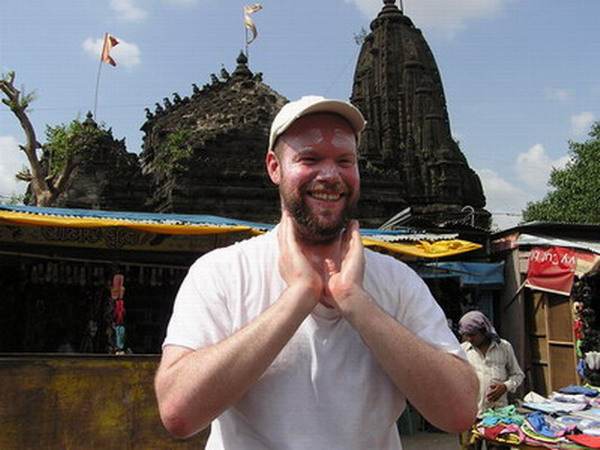
This vendor was selling fish straight out of the water next to him, which he had just cut the heads off of. There were flies and blood and guts everywhere. You can just imagine how pleasant it smelled.
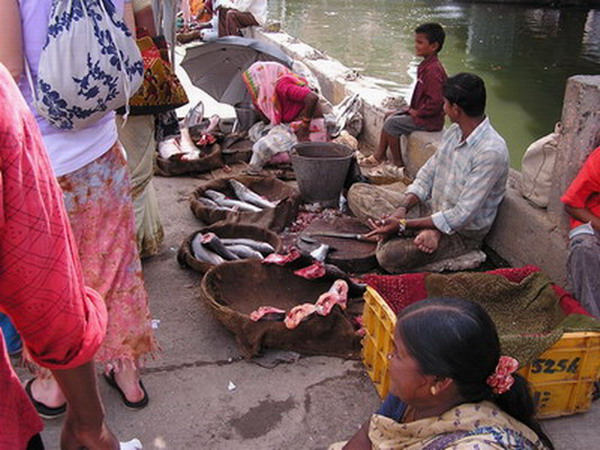
This is a great example of how the cows in India basically run the place. They share the same food, water, and land rights as humans. They are free to wander wherever they please. They have no owners, and are revered as holy animals. People often will feed them scraps for good karma. The cars in India will not stop for bikes, other cars, pedestrians, or other animals, but they will come to a dead stop for a cow. It is very interesting to see the difference in treatment from the rest of the world, which only sees cows as hamburgers waiting to be eaten.

This girl is drinking the same water that she just washed her clothes in, which the cows live next to, people throw their trash in, and everyone uses as a toilet.
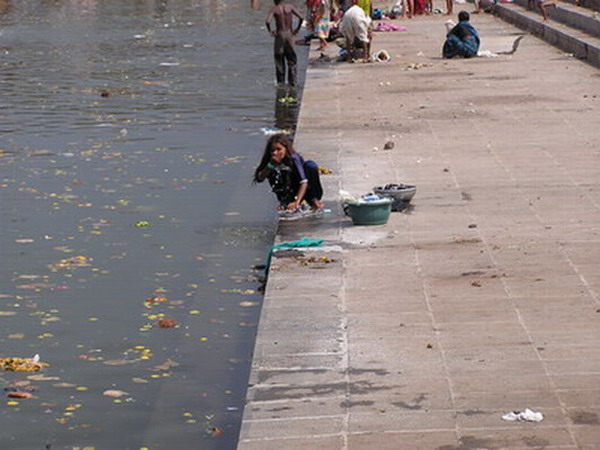
My travel companions for the day.
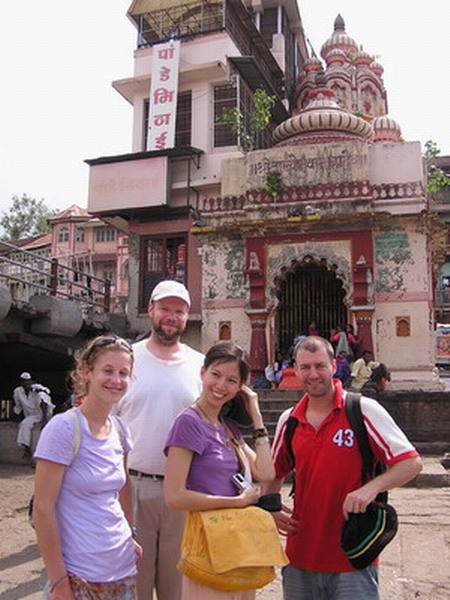
One of the many statues of Ganesha, the remover of obstacles.

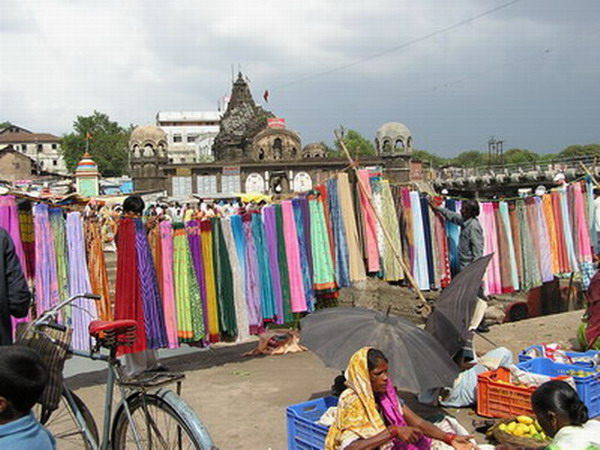
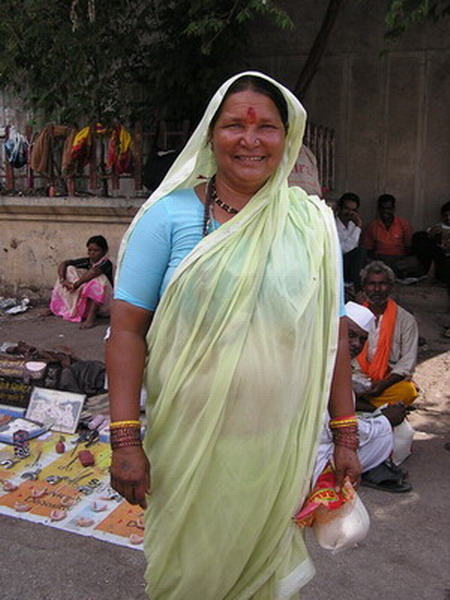
This end of the first couple weeks in India. By this time I was getting quite used to taking a shower out of a bucket of cold water, observing silence during meals, and doing yoga for 4 hours a day. After the second week at the ashram the rains started. It seemed that the heavens opened up and started throwing huge buckets of water down to earth with gusty winds added in just for fun. You will see the landscape change before your eyes in the next post.
Hari Om,
Anna
Iraqi Flora and Fauna — Small
I know it has been a while since I posted a new entry. My apologies for the delay. This is the first of what I hope is at least a two part post. I am trying to capture an image of all the fauna I see running around.
As I become more familiar with my location, I see more and more life teeming all around. Although I don’t want to get particularly close to some of it, it’s fascinating to watch.
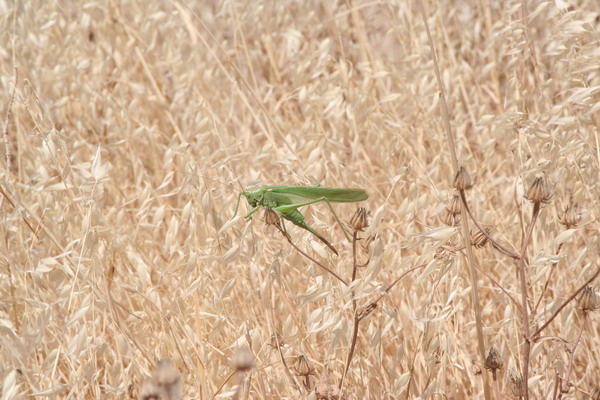
As you can see, this isn’t living fauna, per se, but it’s fitting for the base. 🙂 This work of art was created my one of the craftsmen here.
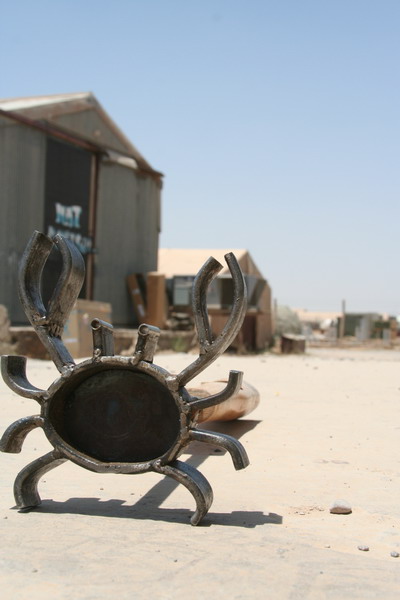
In the desert, one doesn’t normally expect to find a koi pond. However, here the brine water (the by-product of water purification) has to go somewhere. It creates a little lake and the operators have discovered koi enjoy the water.
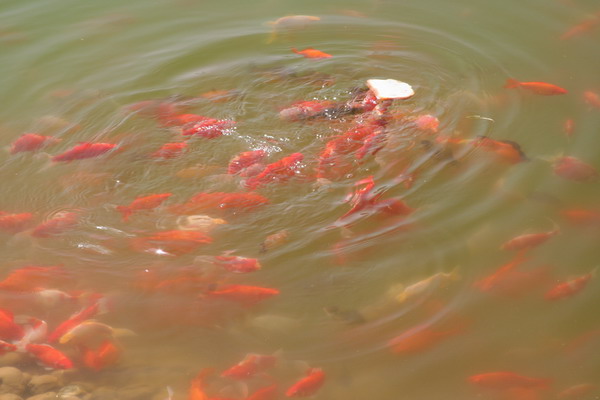
This predator is adept at digging beneath the sand. In fact, as a result it is named the Sand Boa. In the hot desert sun, the sand provides needed relief for this reptile. It often buries itself and only exposes its head, waiting for a small rodent to scurry by. Like all boas, it uses constriction to subdue its prey.
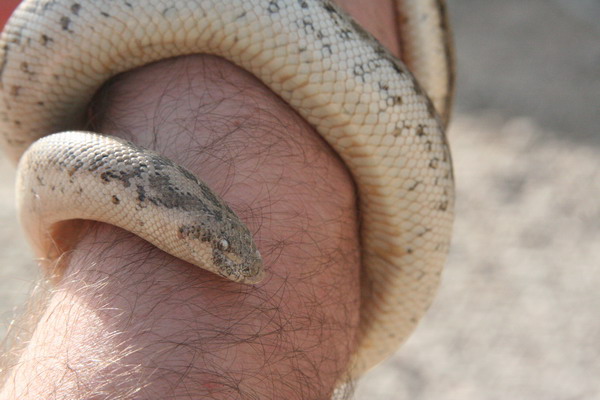
In fact, this cute, little guy could end up being dinner for the sand boa.
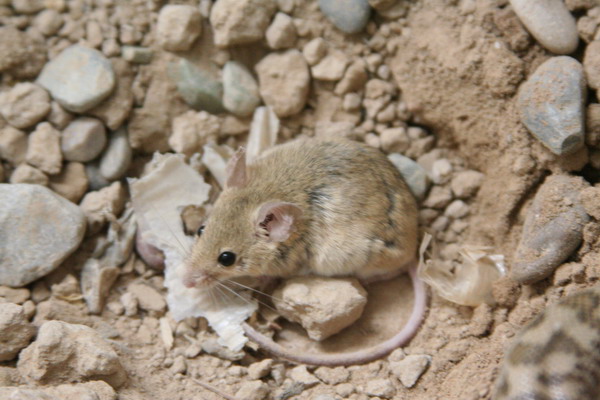
The Praying Mantis.
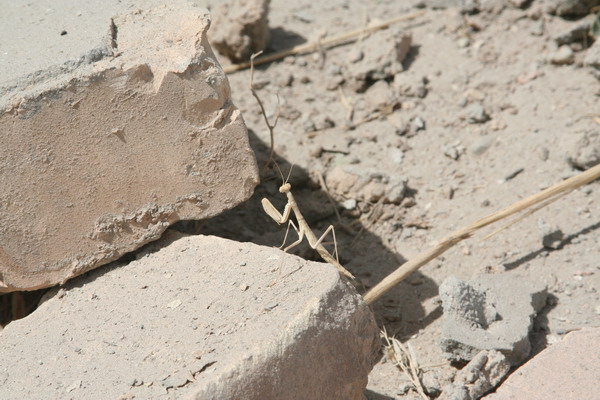
This is an example of fauna that I don’t want to get too close to. Unfortunately, he chose to get close to me this week. In my room here, I have 5 glue covered white boards on the floor. They are intended to catch rodents, but as you can see here, it also catches other little critters. This particular scorpion got stuck to the one that is right next to my bed… Fortunately, he chose to traverse the board, instead of my bed. If you’re interested in this particular species, its scientific name is Androctonus crassicauda. I originally thought he was only a “medium dangerous” species, but just got an email from a scorpion expert correcting me and said that this little guy is “bad boy #1” and is perhaps the most deadly scorpion in the region. Nice, huh?
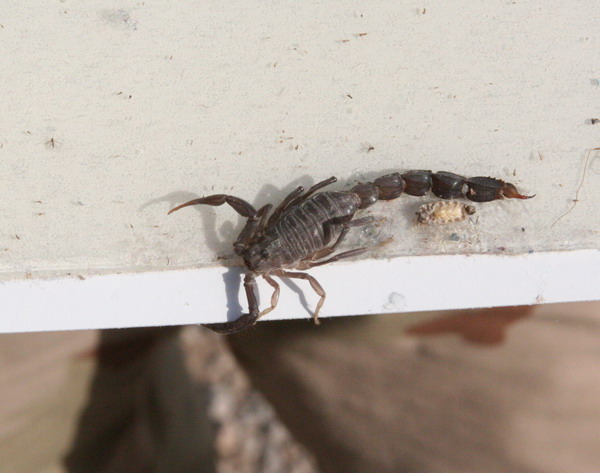
Here’s another image of him with his pincers open.
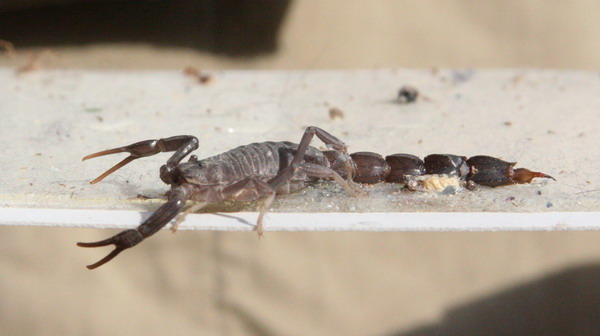
As an aside, I also discovered a small (relatively) harmless scorpion in my office as well. So, they are rather common here. For those of you who live in the desert, it’s no big deal, but this is my first time seeing a number of them in a short period of time. The scorpion below is, Mesobuthus eupeus. Supposedly, its sting is painful, but not as serious as the one above.
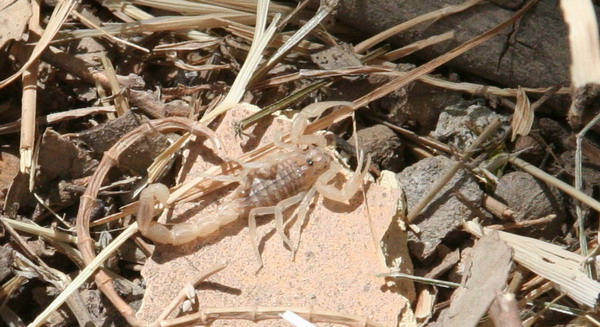
Then, to finish the fauna section, with a friendlier animal.
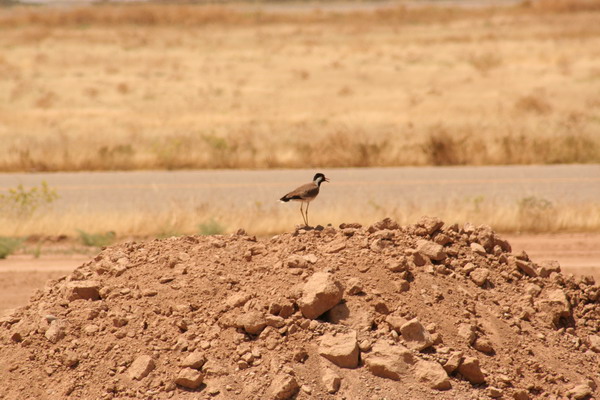
The last and only image of flora from the area is this flower. It bloomed for about 3 weeks, then disappeared.

Well, that sums up the small flora and fauna from my area here. Hopefully, I will be able to add another post with more plants and animals soon.
So, until the next post.
–Jim
Army promotion
Recently, I had the honor of leading a promotion ceremony for an Army Lieutenant. It’s not often sister services are able to partake in these kind of ceremonies.
The order from the President authorizing the promotion was read in front of her platoon at the base post office which they run.
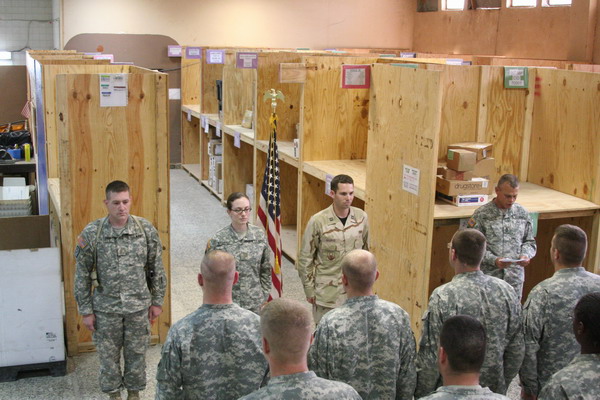
Then, I administered the Oath of Office, which is the oath to affirm officers of the military will support and defend the Constitution of the United States against all enemies, foreign and domestic.
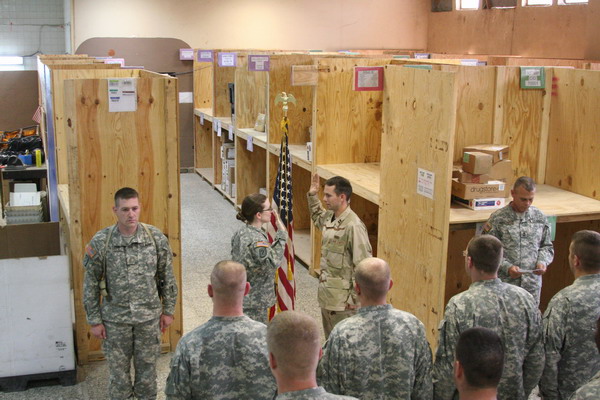
At the conclusion of the oath, salutes were exchanged.
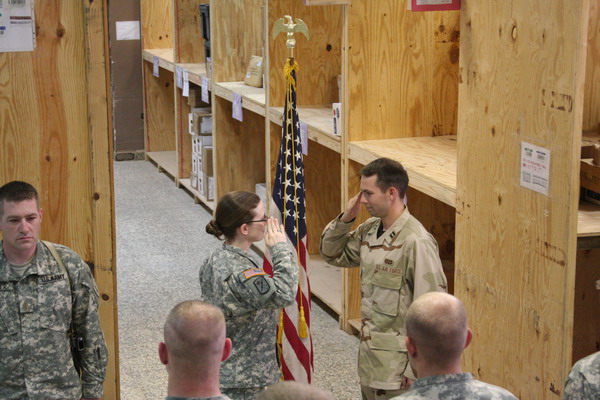
And the congratulatory handshake.
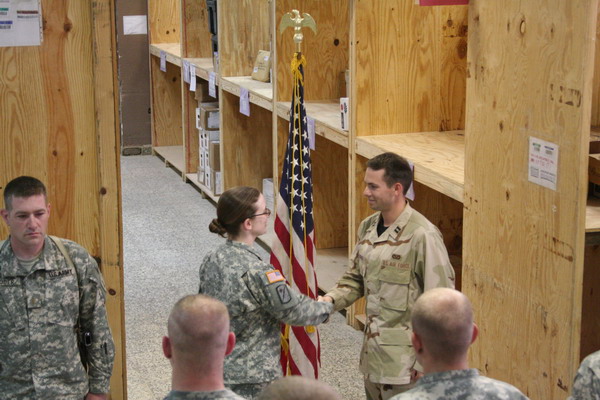
It’s convenient that Army rank is now affixed with Velcro, since her gold second lieutenant rank was ripped off and replaced with the silver, first lieutenant bar.
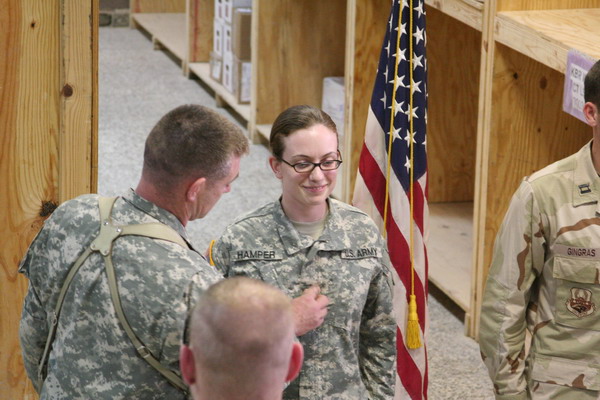
Finally, she ended with a few comments to her soldiers. The promotion from second lieutenant to first is an significant step in a military career. The new rank carries with it an increase in stature, but also an increase in responsibility and accountability.
As an Air Force Airman, it was an honor to be a part of this important ceremony for an Army Soldier.
–Jim
